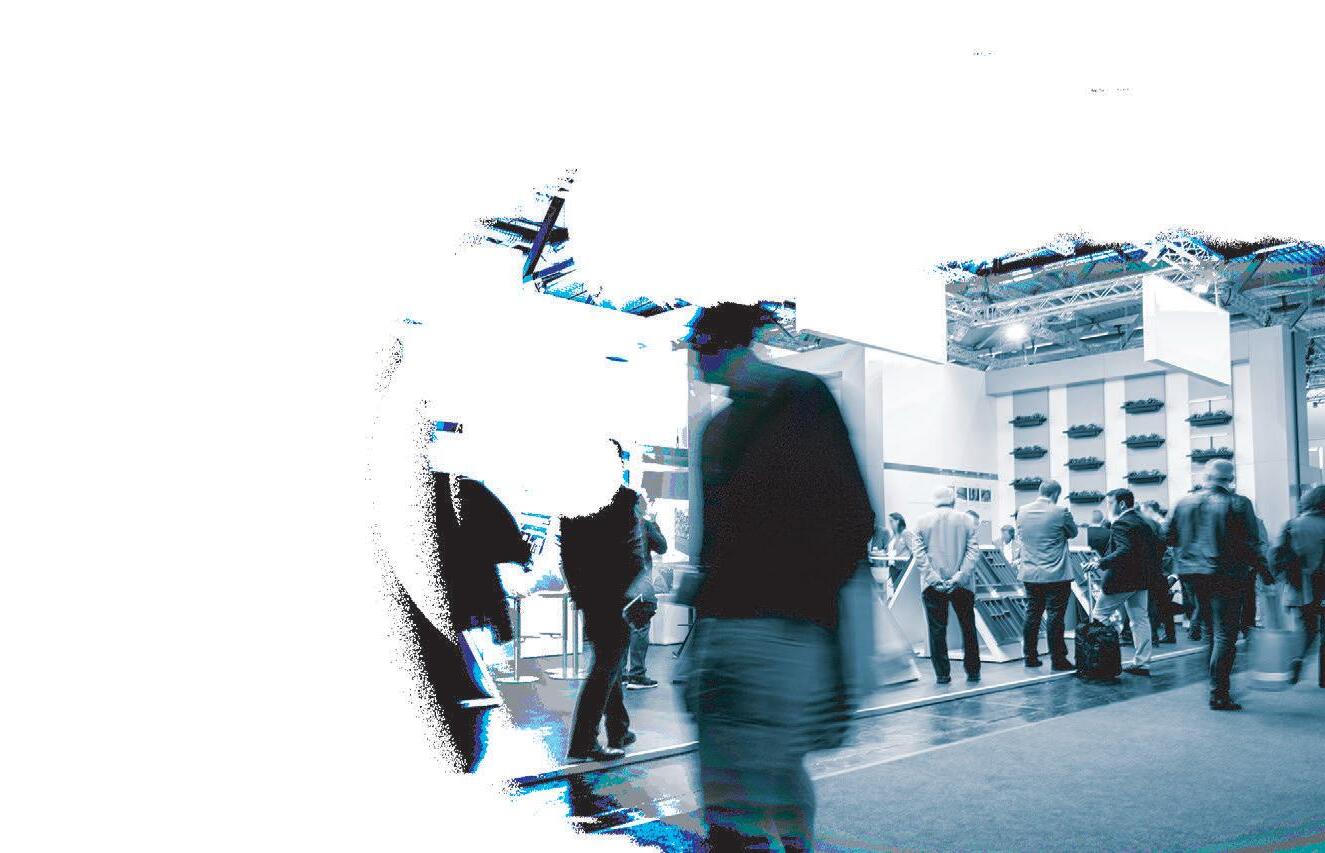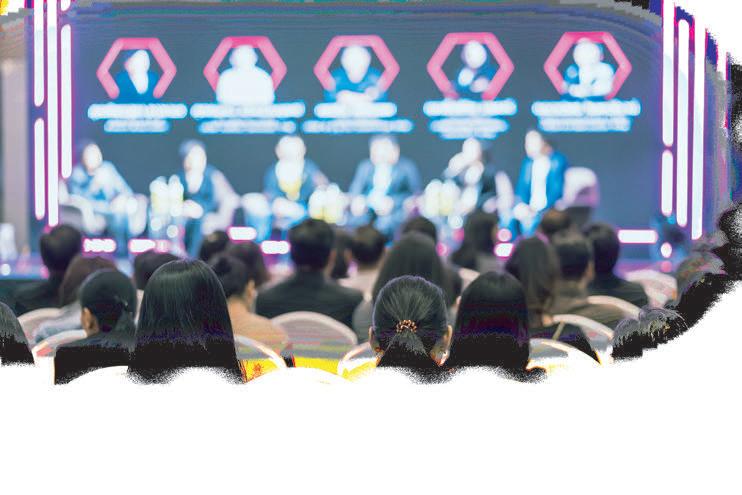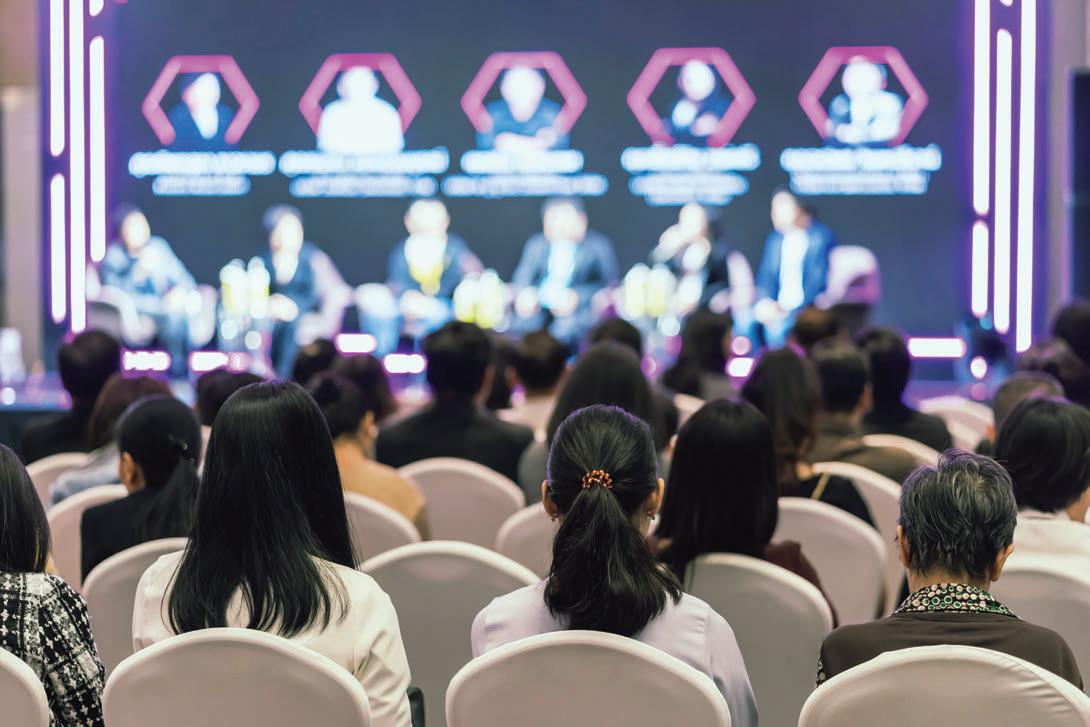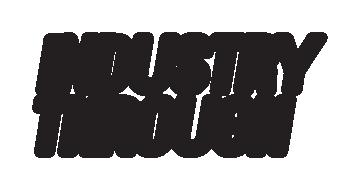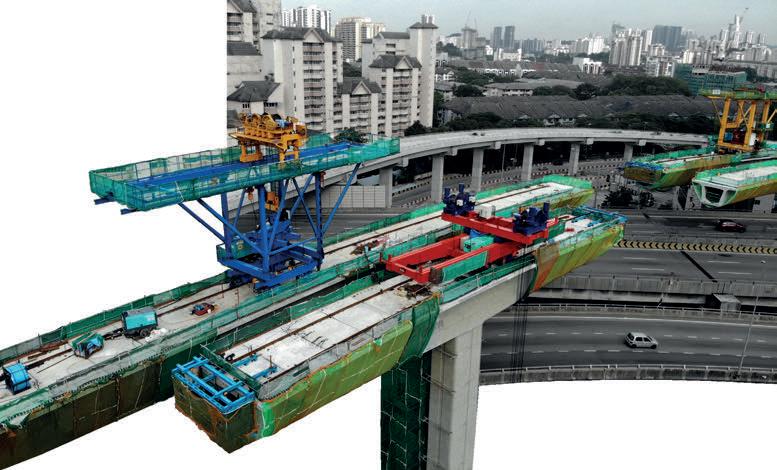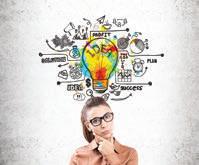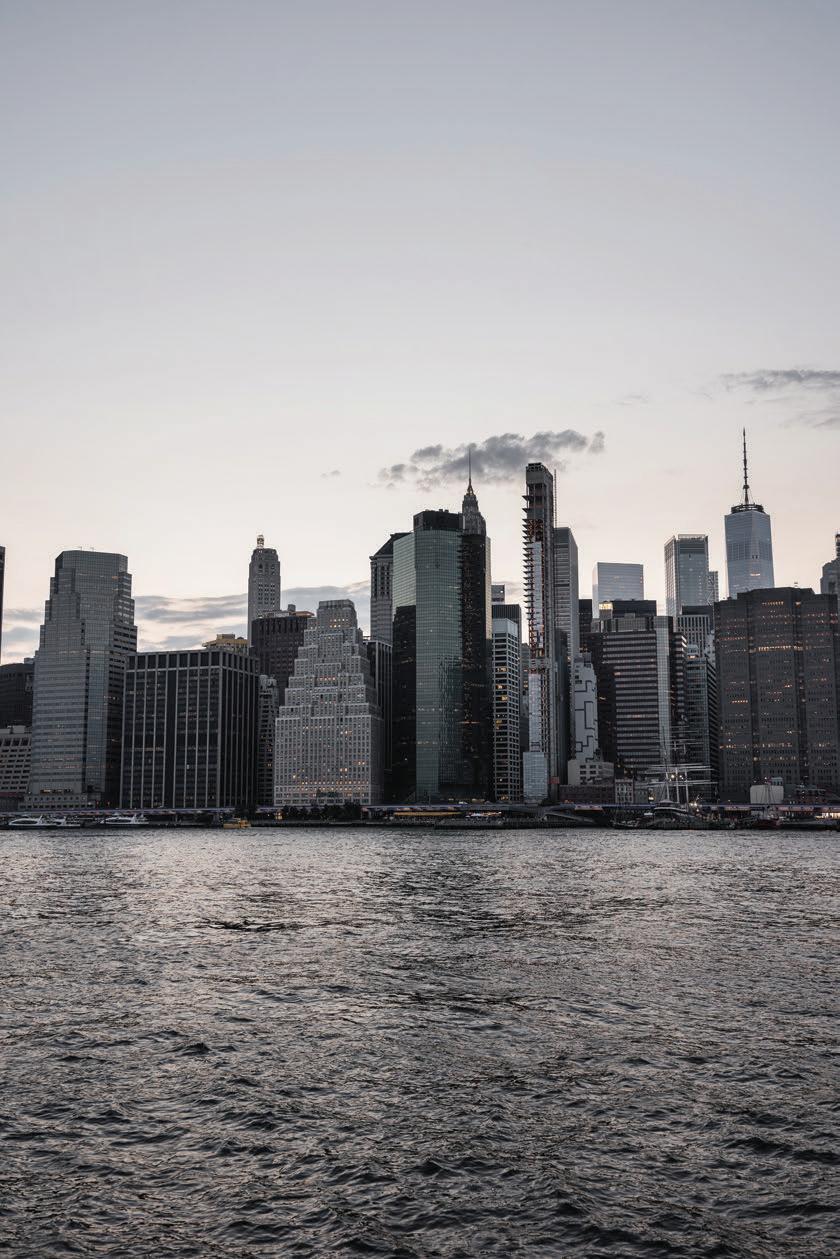












































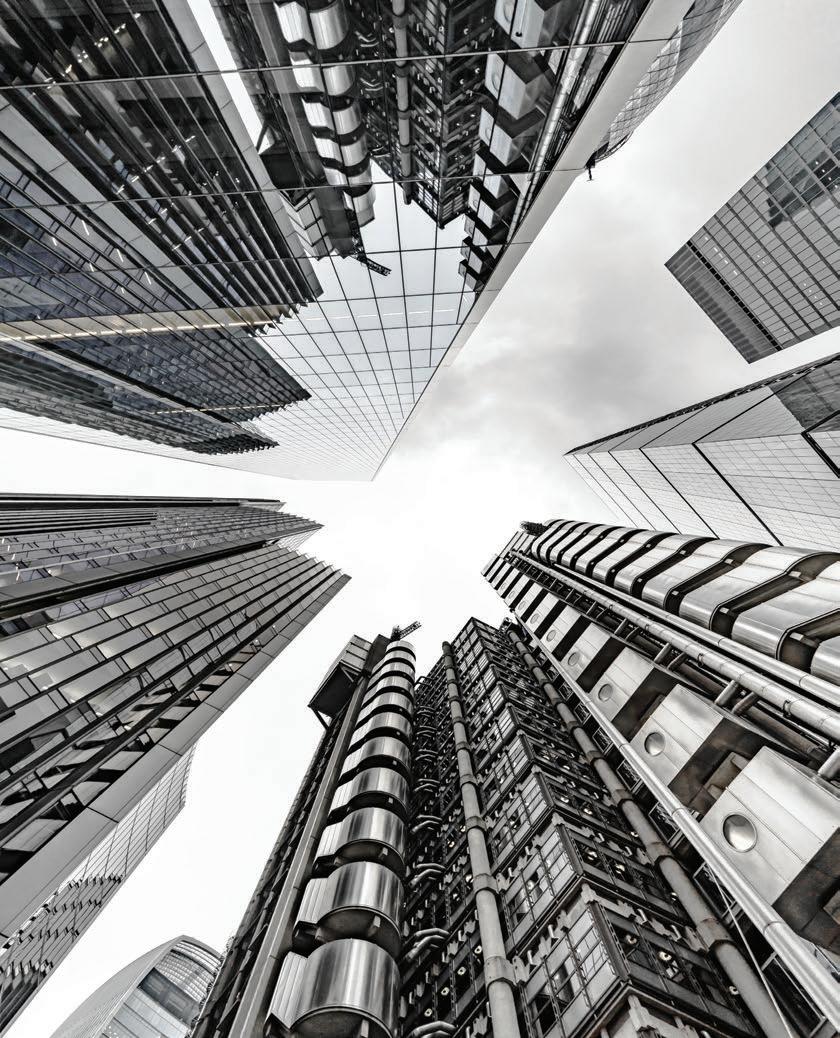
3,200/page RM 3,200/page
Full-Page, Full-Colour Advertisement
This one-time-only special rate o er is for new advertisers.
Space availability is subject to booking on a first-come-first-served basis.
Clients will provide ready-to-print artwork in PDF format with 300dpi.
Full page: 210mm x 285mm, 5mm extra bleed sizes for 4-sided with crop mark.
Advertising space must be utilised before 31 December 2023.
*Please note that the above rate will be subjected to 6% SST. For overseas advertisers, an additional 25% will be charged.
Rate shown above excludes 15% advertising agency commission.
Payment term: Full advance payment.
Artwork submission deadline is on (or before) the 1st week of the prior month of publication. After the material deadline, no cancellation or alteration to the advertisement will be entertained.
Any cancellation after signing the advertising order will result in a 50% penalty charge. The publisher reserves the right to edit, revise or reject any advertisement deemed unsuitable or inappropriate.
JURUTERA has an estimated readership of 200,000 professionals. Our esteemed readership consists of certi ed engineers, decision making corporate leaders, CEOs, government o cials, project directors, entrepreneurs, project consultants, engineering consulting rms and companies involved with engineering products and services. Circulation & Readership Pro le

MAJLIS BAGI SESI 2023/2024 (IEM COUNCIL SESSION 2023/2024)
YANG DIPERTUA / PRESIDENT
Ir. Prof. Dr Norlida bt Buniyamin
TIMBALAN YANG DIPERTUA / DEPUTY PRESIDENT
Ir. Prof. Dr Jeffrey Chiang Choong Luin
NAIB YANG DIPERTUA / VICE PRESIDENTS
Ir. Mohd Khir bin Muhammad, Ir. Prof. Dr Tan Chee Fai, Ir. Abdul Razak bin Yakob, Ir. Yau Chau Fong,
Ir. Dr Siti Hawa binti Hamzah, Ir. Fam Yew Hin, Ir. Chen Harn Shean
SETIAUSAHA KEHORMAT / HONORARY SECRETARY
Ir. Prof. Dr Zuhaina binti Zakaria
BENDAHARI KEHORMAT / HONORARY TREASURER
Ir. Assoc. Prof. Dr David Chuah Joon Huang
BEKAS YANG DIPERTUA TERAKHIR / IMMEDIATE PAST PRESIDENT
Ir. Ong Ching Loon
BEKAS YANG DIPERTUA / PAST PRESIDENTS
Y.Bhg. Academician Tan Sri Datuk Ir. (Dr) Ahmad Zaidee bin Laidin, Y.Bhg. Dato’ Paduka Ir. Hj. (Dr) Keizrul bin Abdullah, Y.Bhg. Academician Emeritus Tan Sri Dato’ Ir. Prof. Dr Chuah Hean Teik, Y.Bhg. Dato’ Ir. Lim Chow Hock, Ir. Dr Tan Yean Chin
WAKIL AWAM / CIVIL REPRESENTATIVE
Ir. Tu Yong Eng
WAKIL MEKANIKAL / MECHANICAL REPRESENTATIVE
Ir. Ng Yong Kong
WAKIL ELEKTRIK / ELECTRICAL REPRESENTATIVE
Ir. Mohd. Aman bin Hj. Idris
WAKIL STRUKTUR / STRUCTURAL REPRESENTATIVE
Ir. Dr Tan Kuang Leong
WAKIL KIMIA / CHEMICAL REPRESENTATIVE
Ir. Dr Chong Chien Hwa
WAKIL LAIN-LAIN DISPLIN / REPRESENTATIVE TO OTHER DISCIPLINES
Ir. Assoc. Prof. Dr Wong Yew Hoong
WAKIL MULTIMEDIA DAN ICT / ICT AND MULTIMEDIA REPRESENTATIVE
Ir. Assoc. Prof. Dr Lai Khin Wee
WAKIL JURUTERA WANITA / WOMEN ENGINEERS REPRESENTATIVE
Ir. Noorfaizah binti Hamzah
WAKIL BAHAGIAN JURUTERA SISWAZAH / YOUNG ENGINEERS SECTION REPRESENTATIVES
Mr. Muhammad Ashiq Marecan bin Hamid Marecan, Grad. IEM, Mr. Lim Yiren, Mr. Darshan a/l Balasubramaniam, Grad. IEM, Mr. Ooi Wei Chien, Grad. IEM, Ms. Ong Ye Shian, Grad. IEM
AHLI - AHLI MAJLIS / COUNCIL MEMBERS
Ir. Dr Vigna Kumaran a/l Ramachandaramurthy (casual vacancy for Ir. Dr Siti Hawa binti Hamzah for 1 session), Ir. Assoc. Prof. Dr Lee Tin Sin, Ir. Mah Way Sheng, Ir. Sreedaran Raman, Ir. Lee Cheng Pay, Ir. Dr Kannan a/l M. Munisamy, Ir. Dr Siow Chun Lim, Ir. Wong Chee Fui, Ir. Ts. Assoc. Prof. Dr Hum Yan Chai, Ir. Tiong Ngo Pu, Ir. Rusnida binti Talib, Ir. Prof. Dr Lau Hieng Ho, Ir. Muhammad Azmi bin Ayub, Ir. Arul Hisham bin Abdul Rahim (casual vacancy for Ir. Fam Yew Hin - for 2 sessions), Ir. Razmahwata bin Mohd Razalli, Ir. Simon Yeong Chin Chow, Ir. Dr Chan Seong Phun, Ir. Yam Teong Sian, Ir. Kwok Yew Hoe, Ir. Dr Lee Choo Yong, Ir. Sharifah Azlina binti Raja Kamal Pasmah, Ir. Ts. Dr Wan Syakirah binti Wan Abdullah, Ir. Dr Mui Kai Yin, Ir. Shamil bin Abu Hassan, Ir. Wan Rizaluddin Abdullah bin Wan Ali, Ir. Prof. Dr Lam Wei Haur (casual vacancy for Ir. Prof. Dr Zuhaina bt Zakaria for 3 sessions) AHLI - AHLI MAJLIS JEMPUTAN / COUNCIL MEMBERS BY INVITATION
Ir. Lai Sze Ching, Ir. Gopal Narian Kutty, Y.Bhg. Dato’ Prof. Ir. Dr Mohd Hamdi bin Abd Shukor PENGERUSI CAWANGAN / BRANCH CHAIRMAN
1. Pulau Pinang: Ir. Chan Wah Cheong
2. Selatan: Ir. Thayala Rajah s/o Selvaduray
3. Perak: Ir. Assoc. Prof. Dr Nursyarizal bin Mohd Nor 4. Pahang: Ir. Ab Rahman bin Hashim
5. Kedah-Perlis: Ir. Roshasmawi bin Abdul Wahab
6. Negeri Sembilan: Ir. Shahrin Amri bin Jahari
7. Kelantan: Ir. Abrizan bin Abdul Kadir
8. Terengganu: Ir. Mazlan bin Che Ku Ahmad
9. Melaka: Ir. Ong Yee Pinn
10. Sarawak: Ir. Sim Hui Kheng, Stephanie
11. Sabah: Ir. Chin Tet Fu, Willy
12. Miri: Ir. Chong Boon Hui
AHLI JAWATANKUASA INFORMASI DAN PENERBITAN/ STANDING COMMITTEE ON INFORMATION AND PUBLICATIONS 2023/2024
Pengerusi/Chairman: Ir. Abdul Razak bin Yakob Naib Pengerusi/Vice Chairman: Ir. Dr Siow Chun Lim Setiausaha/Secretary: Ir. Ts. Assoc. Prof. Dr Hum Yan Chai Ketua Pengarang/Chief Editor: Ir. Abdul Razak bin Yakob Pengarang Prinsipal Buletin/ Principal Bulletin Editor: Ir. Razmahwata bin Mohamad Razalli Pengarang Prinsipal Jurnal/Principal Journal Editor: Ir. Ts. Assoc. Prof. Dr Teo Fang Yenn Pengerusi Aplikasi Mudah Alih IEMGo/IEMGo Mobile Application Chairman: Ir. Dr Bhuvendhraa Rudrusamy Pengerusi Penglibatan Ahli/Members Engagement Chairperson: Ir. Rusnida binti Talib Pengerusi Pusat Sumber/Resource Centre Chairman: Ir. Dr Kannan a/l M. Munisamy
Ahli-Ahli/Committee Members: Ir. Ong Guan Hock, Ir. Lee Chang Quan, Ir. Lau Tai Onn, Ir. Dr Oh Seong Por, Ir. Yee Thien Seng, Ir. Dr Lee Choo Yong, Ir. Ts. Dr Tan Kim Seah, Ir. Assoc. Prof. Dr Lee Tin Sin, Dr Sudharshan N. Raman, Grad. IEM, Ms. Michelle Lau Chui Chui, Grad. IEM, Ir. Tu Yong Eng, Dr Nor Ilia Anisa Aris, Grad. IEM, Mr. Muhd Ashiq Marecan bin Hamid Marecan, Grad. IEM, Mr. Chuah Pei Lim, Grad. IEM
LEMBAGA PENGARANG/EDITORIAL BOARD 2023/2024
Ketua Pengarang/Chief Editor: Ir. Abdul Razak bin Yakob Pengarang Prinsipal Buletin/ Principal Bulletin Editor: Ir. Razmahwata bin Mohamad Razalli Ahli-ahli/Committee Members: Ir. Dr Siow Chun Lim, Ir. Lau Tai Onn, Ir. Ong Guan Hock, Ir. Yee Thien Seng, Ir. Dr Oh Seong Por, Ir. Ts. Assoc. Prof. Dr Teo Fang Yenn, Dr Sudharshan N. Raman, Ir. Tu Yong Eng, Ir. Lee Chang Quan,Ir. Dr Lee Choo Yong, Ir. Ts. Dr Tan Kim Seah, Ms. Michelle Lau Chui Chui, Grad. IEM
Secretariat: Janet Lim, Nurul Aida binti Mustafa, Nur Illyarnie binti Rosman
THE INSTITUTION OF ENGINEERS, MALAYSIA Bangunan Ingenieur, Lots 60 & 62, Jalan 52/4, P.O. Box 223, (Jalan Sultan), 46720 Petaling Jaya, Selangor Darul Ehsan. Tel: 603-7968 4001/4002 Fax: 603-7957 7678 E-mail: sec@iem.org.my Homepage: http://www.myiem.org.my
Hydrogen the Key to Deep Decarbonisation
Hydrogen as an Energy Source
Introductory Safety Engineering Education: Exposure through Corporative Problem-Based Learning for University Students





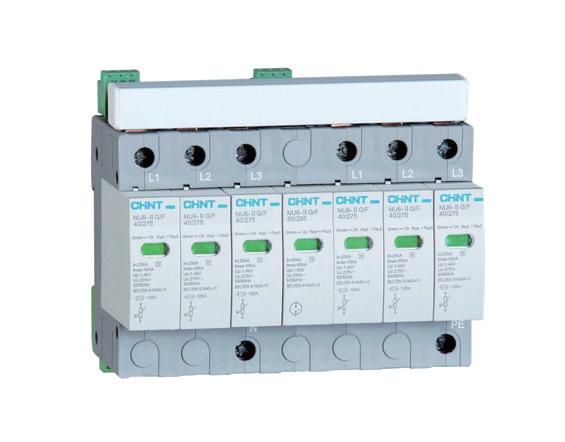

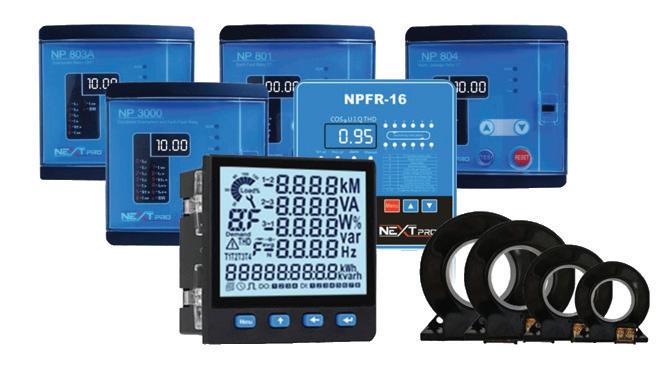





DIMENSION PUBLISHING SDN. BHD. [ 199701034233 (449732-T) ]
Level 18-01, PJX-HM Shah Tower, No. 16A, Persiaran Barat, 46050 Petaling Jaya, Selangor Darul Ehsan, Malaysia.
Tel: +(603) 7493 1049 Fax: +(603) 7493 1047
E-mail: info@dimensionpublishing.com
Website: www.dimensionpublishing.com
CHAIRMAN
ROBERT MEBRUER
CEO/PUBLISHER
PATRICK LEUNG
GENERAL MANAGER
SHIRLEY THAM ● shirley@dimensionpublishing.com
HEAD OF MARKETING & BUSINESS DEVELOPMENT
JOSEPH HOW ● joseph@dimensionpublishing.com
PRODUCTION EDITOR
TAN BEE HONG ● bee@dimensionpublishing.com
CONTRIBUTING WRITERS
PUTRI ZANINA ● putri@dimensionpublishing.com
HANNA SHEIKH MOKHTAR ● hanna@dimensionpublishing.com
SENIOR GRAPHIC DESIGNER
SOFIA HANIS ● sofia@dimensionpublishing.com
GRAPHIC DESIGNER
NICOLE THENG ● nicole@dimensionpublishing.com
ADVERTISING CONSULTANTS
THAM CHOON KIT ● ckit@dimensionpublishing.com
ACCOUNTS CUM ADMIN EXECUTIVE
YEN YIN ● yenyin@dimensionpublishing.com
For advertisement placements and subscriptions, please contact: DIMENSION PUBLISHING SDN. BHD. [ 199701034233 (449732-T) ]
Level 18-01, PJX-HM Shah Tower, No.16A, Persiaran Barat, 46050 Petaling Jaya, Selangor Darul Ehsan, Malaysia.
Tel: +(603) 7493 1049 Fax: +(603) 7493 1047 E-mail: info@dimensionpublishing.com
Subscription Department E-mail: info@dimensionpublishing.com
JURUTERA is published and printed monthly by Dimension Publishing Sdn. Bhd.
JURUTERA MONTHLY CIRCULATION: OVER 50,000 MEMBERS
Submission or placement of articles in JURUTERA could be made to the:Chief Editor
THE INSTITUTION OF ENGINEERS , MALAYSIA (IEM) Bangunan Ingenieur, Lots 60 & 62, Jalan 52/4, P.O. Box 223 (Jalan Sultan), 46720 Petaling Jaya, Selangor. Tel: +(603) 7968 4001/4002 Fax: +(603) 7957 7678 E-mail: pub@iem.org.my or sec@iem.org.my IEM Website: http://www.myiem.org.my
© 2023, The Institution of Engineers, Malaysia (IEM) and Dimension Publishing Sdn. Bhd.
PUBLICATION DISCLAIMER
The publication has been compiled by both IEM and Dimension with great care and they disclaim any duty to investigate any products, process, services, designs and the like which may be described in this publication. The appearance of any information in this publication does not necessarily constitute endorsement by IEM and Dimension. There is no guarantee that the information in this publication is free from errors. IEM and Dimension do not necessarily agree with the statement or the opinion expresssed in this publication.
COPYRIGHT
JURUTERA Bulletin of IEM is the official magazine of The Institution of Engineers, Malaysia (IEM) and is published by Dimension Publishing Sdn. Bhd. The Institution and the Publisher retain the copyright over all materials published in the magazine. No part of this magazine may be reproduced and transmitted in any form or stored in any retrieval system of any nature without the prior written permission of IEM and the Publisher.
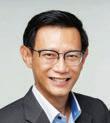
by Ir. Kwok Yew Hoe Deputy Chairman, Electrical Engineering Technical Division
Hydrogen is energy-dense, storable and does not produce greenhouse gases. It can help us achieve a clean energy landscape in the future, so it is the focus of the September 2023 issue of the JURUTERA Bulletin. Malaysia will launch its Hydrogen Economy & Technology Roadmap (HETR) which is expected to be released in 2H2023. This is expected to have an impact in reducing greenhouse gas emissions and to support the Low Carbon Aspirations 2040 under the National Energy Policy 2022-2040.
Hydrogen can be extracted from fossil fuels or water. While natural gas is currently the main source for hydrogen production, the future scope for lowcarbon production of hydrogen from electrolysis of water using renewable energy is gaining momentum vis-a-vis the availability and cost competitiveness of renewable energy.
Currently, hydrogen is used mainly in industries. However, to have a wider reach, it needs to be adopted in sectors such as mobility and power generation.
In Malaysia, the Kuching Urban Transportation System (KUTS) will utilise the hydrogen-powered Autonomous Rapid Transit (ART), supported by a refuelling station and hydrogen production plant developed by SEDC Energy. Tenaga Nasional (TNB) also has plans for its new Paka powerplant to utilise up to 30% of fuel from hydrogen.
Let us look forward to the launch of HETR and play our role in supporting an ecosystem which will be increasingly low carbon and efficient.
An organisation needs assets to realise its goals. We continue our presentation of IEM’s dedicated staff members.
Cik Farezah binti Junaidi joined IEM on 2 January 2013 as Executive handling the processing of student applications. During her 10 years with IEM, she was exposed to all areas under the Standing Committee on Admissions & Practical Training. Having demonstrated her ability to learn fast and having contributed to improving the application processes, she was promoted to Senior Executive in 2022 and tasked with leading the department on admissions and practical training.


Cik Norshafiqah binti Sha’ari joined IEM on 10 June 2013 as Executive handling Technical Divisions. During her short stint in Activities, she also assisted in the organising of the IEM Annual Dinner where she created a more efficient way to handle table layouts. Since then, her assignments have ranged from membership drives to professional interviews. Having demonstrated her versatile ability to excel in any role, she was promoted to Senior Executive in 2022 and was given the responsibility to lead the Examinations & Qualifications department.
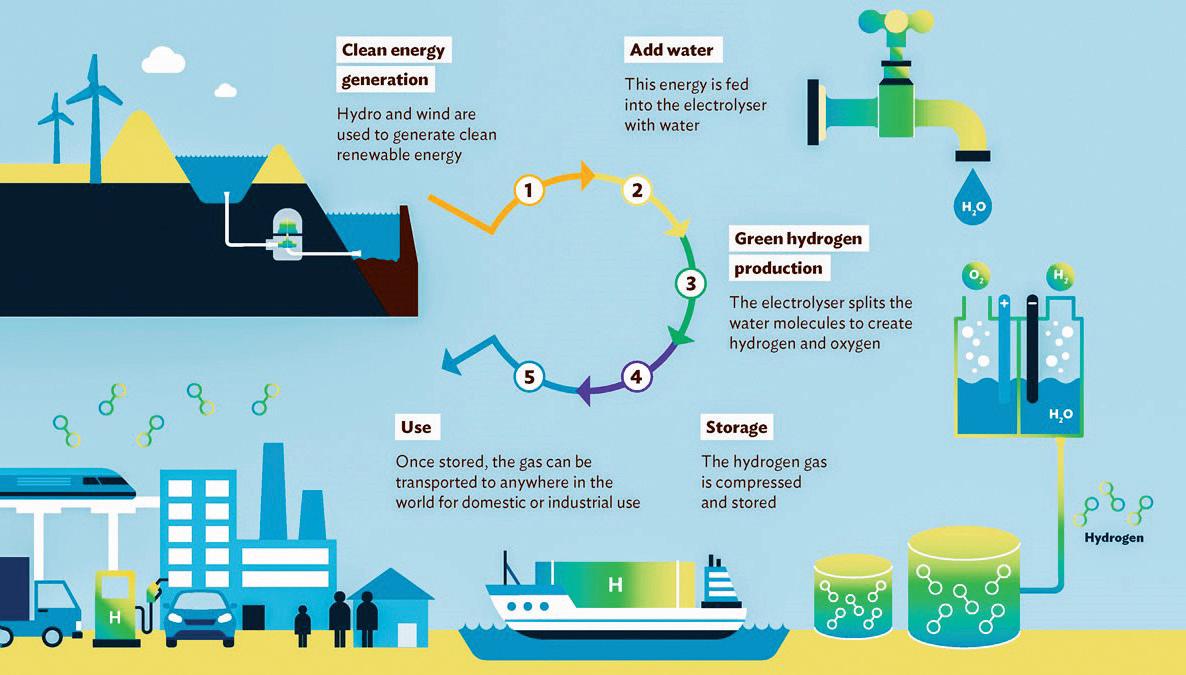

Interview session with:
Tuan Nik Nazmi bin Nik Ahmad
Malaysia’s Minister of Natural Resources, Environment & Climate Change (NRECC) since December 2022. NRECC is a combination of two previous Ministries (Ministry of Energy & Natural Resources and Ministry of Environment & Water).
He has served as MP for Setiawangsa, Kuala Lumpur, since 2018 and as a Vice-President of KEADILAN since 2022. A graduate in Law from King’s College London, he has authored several books; the most recent is his political memoir, Malaysian Son.
One early landmark of his term as minister was the introduction of a policy that not only focused on climate mitigation but also on climate adaptation and resilience. Under his stewardship, Malaysia has also removed the blanket subsidy on electric usage.
Malaysia has been actively promoting the use of Renewable Energy (RE) as an alternative to fossil fuels. Since 2001, Malaysia has had a policy to increase the share of RE in its total energy mix.
One area where we can potentially excel in is the development of hydrogen as an energy source. Hydrogen can be produced using various methods such as electrolysis, thermolysis or biophotolysis and, when used as fuel, it produces only water vapour and heat as emissions.
Grey hydrogen is produced from natural gas through steam methane reforming (SMR), a process that releases significant amounts of carbon dioxide into the atmosphere. It is the most common type of hydrogen currently used in industrial applications.
Blue hydrogen is also produced from natural gas but utilises carbon capture technology to reduce emissions. As carbon dioxide produced during the SMR process is captured and stored instead of being released into the atmosphere, this results in lower greenhouse gas emissions compared to grey hydrogen.
Green hydrogen, on the other hand, is produced using RE sources such as solar or wind power to electrolyse water into hydrogen and oxygen. Green hydrogen has zero greenhouse gas emissions at production and use stages, making it the ideal solution for de-carbonising industries with high energy demand such as steel-making or transportation.
Overall, grey and blue hydrogen are transitional solutions while green hydrogen represents long-term sustainable future possibilities with regard to efficient clean fuel source.
Transitioning Towards a Hydrogen-Based Economy
Malaysia has been delving into the potential of hydrogen as an alternative energy source for several years now. In 2021, the Ministry of Natural Resources, Environment &
Climate Change (NRECC) established a target to attain a 31% share of RE in the national installed capacity mix by 2025. According to its Minister, YB Tuan Nik Nazmi bin Nik Ahmad, the aim of this ambitious yet feasible objective was to mitigate carbon emissions and facilitate Malaysia’s transition towards a low-carbon economy.
“As of 2022, we have achieved a total installed capacity of 25% and are on track to achieve the 31% RE capacity milestone in 2025,” he said in an interview with IEM’s Electrical Engineering Technical Division (EETD) at his office on 25 July 2023. EETD was represented by its Chairman, Ir. Dr Siow Chun Lim, Deputy Chairman Ir. Kwok Yew Hoe, Honorary Secretary and Treasurer Ir. Shamila Ariaratnam as well as committee members Mr. Alex Looi Tink Huey and Ir. Roger Wong Chin Weng. Also present were IEM President Ir. Prof. Dr Norlida binti Buniyamin, IEM Vice Presidents Ir. Yau Chau Fong and Ir. Fam Yew Hin as well as the IEM secretariat representatives.
The energy sector faces various obstacles as we move towards a hydrogen-based economy and the most urgent challenge is grid limitations. To address this issue, Tuan Nik Nazmi emphasised, expanding the grid network was crucial to enable greater penetration of RE in the country. In addition, foreseeable barriers include the nation’s capacity for electricity production, associated costs and current policies at both national and regional levels. He highlighted these concerns in response to a question posed by Ir. Dr Siow regarding Malaysia’s readiness to embrace hydrogen as its primary source of RE in the future.
At the unveiling of the 12th Malaysia Plan on 27 September 2021, it was announced by the then Prime Minister that we aimed to become carbon neutral by 2050, with the inclusion of hydrogen in the government’s strategic thinking about RE.
In order to accelerate a hydrogenpowered energy transition, Tuan Nik
Nazmi said NRECC had developed certain strategies and was on track to embrace a hydrogen energy economy. He disclosed that the Malaysia Energy Transition Outlook Report, commissioned by The International Renewable Energy Agency (IRENA) and NRECC, stated that hydrogen, especially green hydrogen, would be an important energy carrier for the country to effectively de-carbonise hard-to-abate industries such as steel, fertilisers, plastic production and maritime shipping.
“Hydrogen energy comes under the purview of the Ministry of Science, Technology & Innovation (MOSTI). Work on the hydrogen roadmap is under way and will be launched soon. It will help give better clarity on the whole hydrogen energy economy, with a focus on green hydrogen in particular,” explained Tuan Nik Nazmi.
He also said that to be practical, Malaysia needs to start with quite a substantial amount of blue hydrogen and maybe some grey as well although ideally it should only be green hydrogen. However, due to the high cost and other challenges at the moment, this has not been possible.
He said Sarawak is fortunate to possess an abundant and costeffective supply of hydro-power, exemplified by the Bakun Dam, which can be utilised for hydrogen production. However, the creation of green hydrogen in the peninsula may prove more challenging, given the existing technology and pricing constraints.
Collaborations with Private Sectors When asked how the private sector can help bridge the chasm between Malaysia’s aspirations and the present reality with regards to embracing a hydrogen energy economy, Tuan Nik Nazmi said it can assist in many ways.
He believed the private sector will play a vital role in Malaysia’s efforts to establish hydrogen as one of the nation’s key strengths by 2050. “The government will act as intermediary to bring all stakeholders together towards this common goal. We are
aware of the limitations of fossil fuels and their negative impact on our planet, which necessitates this transition. I am confident that major players such as Petronas, along with other participants throughout the supply chain, possess the capability to make this shift successfully,” he said.
He added that the government also recognises the importance of renewable energies such as hydrogen by offering incentives to businesses which adopt these technologies. He explained that the private sector can invest in RE projects, collaborate with the government and regulatory authorities, drive technological innovation, form partnerships and joint ventures, engage with communities and promote education, commit to corporate RE procurement, establish specialised financing platforms, support capacity building and skills development as well as collaborate with research institutions. Such actions will help stimulate investments, create an enabling environment, drive technological advancements, raise awareness and build the necessary infrastructure
and human capital to accelerate RE development in Malaysia.
According to Tuan Nik Nazmi, corporations such as Petronas and TNB are actively engaged in hydrogen-related initiatives, while several other businesses have expressed interest in investing.
“I believe Petronas truly understands the importance of RE. Despite some cynicism about the oil and gas giant investing in RE due to potential costs, I find it practical. Petronas is well-run and has shown great nimbleness in its commitment to the transition to RE. It’s also in its self-interest to do so,” he said.
NRECC acknowledges the pivotal role of hydrogen in the country’s aim to achieve net zero emissions by 2050. Tuan Nik Nazmi said that of the various technologies, hydrogen stands out as the most promising solution to addressing some of the weaknesses associated with solar power.
As pointed out by Ir. Dr Siow, hydrogen-powered public transportation buses are already in
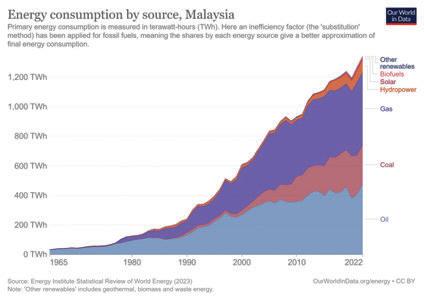
Data published by Energy Institute Statistical Review of World Energy (2023), which analyses data on world energy markets from the prior year. Previously produced by BP, the Review has been providing timely, comprehensive and objective data to the energy community since 1952. Link: https://www.energyinst.org/statistical-review/
operation in Sarawak. Given the state’s vastness, such developments will also prove beneficial for many other communities. With this in mind, Tuan Nik Nazmi explained, the NRECC is in preliminary discussions with plans to foster analogous developments in a few other states.
“We are engaged in discussions with the federal government; our extensive experience with gas, including LNG, provides us with an advantageous position for the transition to a hydrogen economy. However, discussions are still in the preliminary stages. Though we are engaged in talks with Sarawak, Petronas and TNB on a state-level basis, there is still much work to be done before a clear picture emerges. We anticipate gaining more clarity following the launch of the hydrogen roadmap,” said Tuan Nik Nazmi.
“I believe that sustainability has become increasingly critical for the private sector. It is evident that discussions have shifted from solely focusing on a company’s financial performance, where being in the black or red was once paramount. Today, it is more crucial to consider whether a business operates sustainably and is ‘green’.”
He said some individuals still show cynicism about the notion of environmental sustainability and feel it’s all just a public relations stunt. “However, the public must realise that without a healthy planet, there will be no consumers and consequently no market for goods and services. The government can certainly play a crucial role in shaping policies which encourage sustainable practices and drive innovation where the market falls short. Nevertheless, we must also acknowledge the private sector’s strength in terms of flexibility and innovation. Therefore, we should strive to leverage this strength while transitioning from fossil fuels to hydrogen-based energy sources in the not-so-distant future,” he added.
Transitioning towards sustainable energy sources is not only in the interests of the public but also aligns with the private sector’s bottom line. “As carbon pricing becomes higher, companies will increasingly value sustainability. While fossil fuels continue to play a crucial role today, I anticipate that this industry will eventually decline due to its inherent limitations. Therefore, it will be wise for companies involved in these sectors to embrace renewable and green energies, including hydrogen, as part of their long-term strategies,” he said while admitting that although technological capabilities are available, pricing details remain an obstacle to progress.
Despite the obvious potential of green hydrogen as a significant contributor to the overall hydrogen generation and consumption in Malaysia, Tuan Nik Nazmi said it still lacks a multiplier impact on the RE industry. “The reason is that it is not viable, economically, to transform RE to another form unless there is excess energy. In our current and (near) future state, we don’t foresee Malaysia having excess RE in our power system,” he explained.
In preparing for a significant shift towards a hydrogen economy, he said there will be a need for technical and vocational education to support the emerging industry.
“To plan ahead, it is crucial to develop specialised training programmes that cover various aspects of hydrogen technologies, such as production, storage, transportation and utilisation. This includes providing handson training in hydrogen fuel cells, electrolysis, hydrogen infrastructure, safety protocols and system integration,” he said.
Curriculum development should also focus on fostering skills in RE, chemistry, engineering and environmental sustainability.
“Collaborating with industry experts and establishing partnerships with hydrogen-related companies can help ensure that educational programmes are aligned with industry requirements and provide graduates with the necessary skills and knowledge to thrive in the evolving hydrogen economy,” he stressed.
Tuan Nik Nazmi said engineers in Malaysia possess a crucial capacity to facilitate the adoption of RE. These professionals are instrumental in the development and design of sustainable energy systems, driving innovation through technological advancements, overseeing project planning and implementation, integrating renewable resources with existing infrastructure, maintaining optimal functioning of related systems and contributing towards policy formation and regulation. Their expertise is indispensable to ensure efficient utilisation of clean resources while addressing technical hurdles and promoting sustainability. Thus, engineers play an integral role in propelling Malaysia’s transition towards a cleaner future driven by RE sources.
Regarding incentives to encourage local entrepreneurs to participate in the hydrogen economy, he felt the government can play an important role by building capacity and expertise. “Given that hydrogen is still in its nascent stages, it is important for us to take an early lead. We can consider tax breaks, grants or soft loans as ways to support companies interested in making the shift. For many businesses, transitioning towards hydrogen remains risky; however, if the government manages this risk, then they will be more likely to invest and conduct research needed for its successful implementation,” he said.
“Take the case of solar power. While technically possible 10-20 years
ago, it was considered expensive due to low oil prices but now it has become much more affordable and more popular. Therefore, taking action sooner rather than later can reap significant benefits for our economy and environment alike.”
In Malaysia, hydrogen is currently in its early stages of adoption. However, if and when it achieves cost-competitiveness, it has the potential to bring about significant long-term financial impacts on the economy. These include job creation, economic growth, investment opportunities, potential for hydrogen exports, reduced energy import dependency and technological innovation. There will also be environmental and health benefits resulting from this shift.
Ir. Dr Siow then asked Tuan Nik Nazmi for his views on Malaysia’s positioning against other potential producer countries should the government take a market driven approach to hydrogen production, meaning fewer subsidies. The Minister replied that at present and in the near future, hydrogen will remain a heavily subsidised fuel compared with other fuel sources.
“This is a topic that we have not explored in depth, specifically whether or not to adopt a subsidy approach. However, I take a pragmatic stance and acknowledge that subsidies are necessary at the outset. In the past, we subsidised electricity tariffs to attract investors. This was done with the objective of bringing in investors at lower costs and wages. Unfortunately, low wages resulted in workers being unable to afford market prices for energy and this necessitated further subsidies. But while this strategy might have been effective during the 1980s, it might no longer be applicable today,” he said.
“However, it is becoming apparent that change is on the horizon. Therefore, we must elevate ourselves from our current position.
Additionally, the detrimental impact that our actions have had on the environment cannot be ignored. Turning to the topic of hydrogen, I would posit that there are a few matters which require further discussions with key decision-makers such as the PM, EPU, MoF and MOSTI.
“My contention remains that if subsidies for hydrogen are necessary at this juncture due to its strategic importance in various sectors, then these should be implemented accordingly. This constitutes a crucial aspect of our approach moving forward.”
Ir. Prof. Dr Norlida then highlighted the unique natural resources of certain regions such as Sarawak, Sabah and possibly Kelantan which offer a cost-effective source of hydro energy. As a result, there is potential for these states to outpace others such as Negeri Sembilan, in terms of growth. Consequently, it begs the question whether the government should consider subsidising less developed states so that they too can benefit from this opportunity for growth.
“For instance, I come from Kelantan where manufacturing is scarce. If we are unable to produce hydrogen power locally and must resort to importing it from other states, then we risk being left behind even further. Therefore, should the government not contemplate implementing strategies aimed at fostering greater cooperation between all states with an emphasis on sharing resources?” she asked.
To this, Tuan Nik Nazmi said we have to consider that different states have varying strengths, for example Sarawak, Terengganu and Perak which may excel due to the dams in their states.
“As you correctly stated, states such as Selangor, Negeri Sembilan and Penang may not be as competitive in this regard. I believe it is not necessary for every state to produce green hydrogen. However, it is important that we have a national sharing system so that we can achieve the required scale. While it may be fair for states like Sarawak, Terengganu
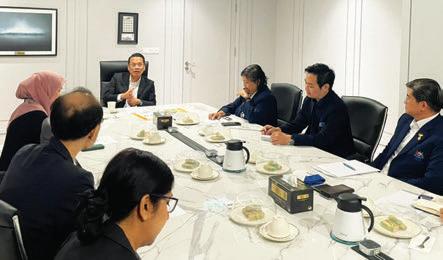
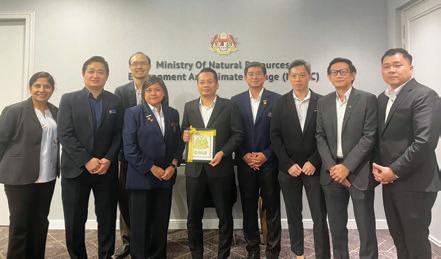
and Kelantan to receive some premium due to their advantages, other states should also have access. At the end of the day, our goal is a better future for the planet. We cannot control what other countries do but we can certainly control what happens within Malaysian borders. Only by working collaboratively can we achieve success and as a small country, working together makes sense in this context,” he asserted.
Regarding the potential implementation of nationwide federal policies for exporting RE to foreign countries, as exemplified by Sarawak’s H2ornbill hydro-electric and Kinabatangan projects in Kalimantan, Tuan Nik Nazmi has assured that all
relevant factors will be taken into consideration when formulating a mutually beneficial policy.
“We should respect the strength and resources of each state, including those in Borneo (Sabah & Sarawak) which hold a special position. However, ultimately we are one country and part of the federation, so it is crucial to find ways to ensure Malaysia benefits as a whole. The main concern previously was that people felt they were not properly compensated or that one party was taking advantage of the other. As long as fairness is demonstrated to everyone involved, we can work within the framework of our country,” he said.
“Before we consider sharing guidelines with international bodies, it is important for us to first establish guidelines for sharing within our own state/country while maintaining control over its distribution. We must avoid selling out and we must ensure that every state has access to affordable resources necessary for growth.
“One question that begs to be asked is whether this is simply a minor addition to our RE trading policy? The previous policy did not allow for export because the energy mix consisted of only 1% solar and had a capacity of 25%, with a mere 6% being utilised.”
He said that although some quarters argue that we should not export due to the increasing demand from data centres and companies in the country, he believed that it is necessary to gradually revise tariffs every six months. “However, we cannot make sudden changes. Singapore is willing to pay a premium price for our excess energy, which can be sold while still leaving enough for domestic use. This will allow us to scale up and reach our ambitious targets by taking advantage of the price difference between Singapore and Malaysia,” he added further.
Amplifying Effect
In light of Ir. Dr Siow’s comment regarding Tuan Nik Nazmi’s unwavering support for green hydrogen, it is pertinent to inquire about the potential amplifying effect that green hydrogen may have on renewable energy as a whole.
“The concept of green hydrogen itself is one that warrants further examination,” said Tuan Nik Nazmi. “While there are a few energy sources that can be deemed as super energy, the controversy surrounding these and their unclear policies make them less desirable options. One such example is nuclear energy. On the other hand, hydrogen presents itself as a viable option due to its low carbon emissions and potential, as water is its only by-product. This makes it an attractive fuel source,
especially when considering its portability and compatibility with EV charging technology. It seems clear that green hydrogen has a place on our future energy landscape.”
Electric vehicles are currently ahead of hydrogen-powered cars in terms of technological advancement, but they do have certain limitations. However, over time, advancements in technology may improve these limitations. One common limitation is time and the inconvenience of charging an electric car as compared to filling up with petrol, which people are accustomed to doing quickly.
“For example, when I used an EV for a long-distance drive at night, I had to settle for a slow charger that took two hours to use. Hydrogen-powered cars, while still in the early stages, may be closer to what people are used to with petrol-fuelled cars and can potentially be more convenient once there are enough fuelling stations. Ultimately, the key factor will be the ease with which drivers can transition from traditional petrol vehicles to alternative options such as electric or hydrogen-powered ones and improve our energy mix overall,” he said.
“Hydrogen offers a unique advantage in complementing other energy sources. While I cannot predict whether cars will be flying by 2050, I can foresee an increase in the number of electric vehicles and hydrogenpowered vehicles on the road. For heavy-duty transportation such as logistics and lorries, there is an argument to suggest that hydrogen will serve as a better fuel than batterypowered alternatives. Moreover, ships can benefit from using hydrogen as well. It’s worth noting that for us to achieve our climate change goals, we must transition towards green hydrogen eventually; however, it’s acceptable to incorporate blue hydrogen into our current mix when starting the shift towards a more sustainable economy.”
If Malaysia invests strategically in creating a supportive ecosystem for the hydrogen sector by fostering innovation and attracting capital inflows to stimulate economic activity within the country’s borders as well as beyond them through exports, then it can position itself as a leader in this field while promoting sustainable prosperity going forward.
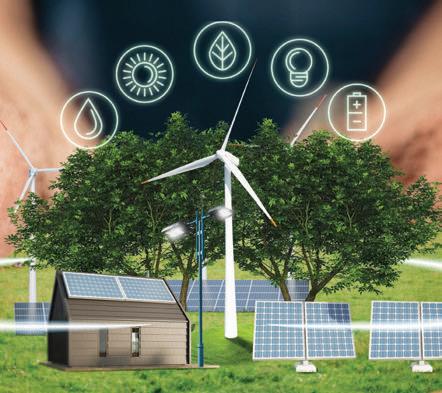















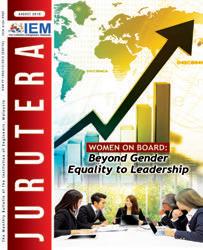






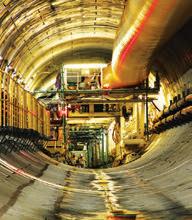

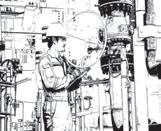






















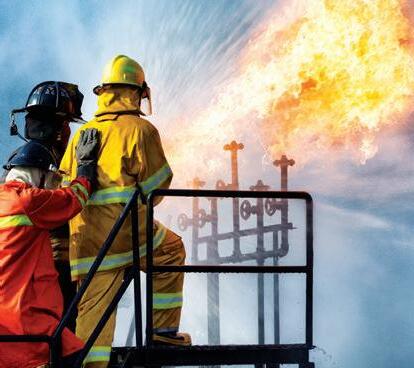






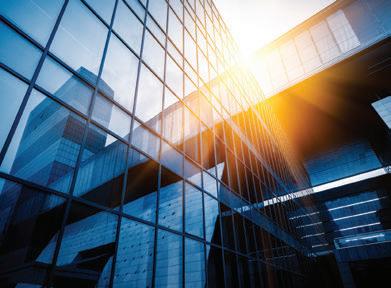








































Written and Prepared by:

Dr Wong Wai Yin
She has a PhD in Fuel Cell Engineering from Universiti Kebangsaan Malaysia with National Science Fellowship Malaysia Award. She is leading a consultancy project on hydrogen production through electrolysis and is chairman of a sub-working group under the Malaysian Technical Standard Forum Bhd.
Hydrogen gas, the lightest gas in the world, is now at the forefront of the race to achieve netzero emissions. Hydrogen, which can be easily produced just from water, has become a key focus in efforts to decarbonise the carbon-driven economy. As we strive towards a more sustainable future, hydrogen has the potential to play a crucial role in reducing our carbon footprint and mitigating the impacts of climate change.
An energy carrier is a substance or system that can transport or deliver energy from its source to the point of consumption. Common examples of energy carriers are electricity, fuel (hydrocarbon or non-hydrocarbon) and heat; each has its own unique properties and advantages, depending on the application and purpose.
Hydrogen has the potential to become a major green energy carrier in the future due to its high gravimetric

Assoc. Prof. Ts. Dr Lim Kean Long
He has a PhD from University of New South Wales, Australia. He specialises in hydrogen storage and advanced energy materials. He has led many research projects in hydrogen energy and is a subject matter expert for MyNet Zero Emission Roadmap 2050.
energy density. In other words, hydrogen can store a large amount of energy per unit mass, making it an efficient and convenient energy carrier option in transportation. In comparison to two other energy carriers (petrol and batteries) in transportation, hydrogen has a gravimetric energy density of about 120-142 MJ/kg, approximately 3 times higher than that of petrol and more than 130 times higher than that of batteries. The inherent properties of hydrogen render it an immensely compelling choice for applications where weight and space are critical factors to be reckoned with [1]
In addition, hydrogen has the unique ability to store energy without losing its capacity over time, making it an ideal solution for long-term energy storage and seasonal energy balancing. For example, during peak production periods with solar energy in excess, the excess energy can be used to produce green hydrogen through water splitting or electrolysis. The hydrogen produced can

then be stored for use later during high demand periods. Hydrogen stands as a unique energy storage option for renewable energy (RE), possessing unparalleled flexibility in terms of storage and transfer capabilities. Unlike batteries (which are limited by their capacity) and pumped hydro (which relies on specific geological locations), hydrogen exhibits the ability to scale accordingly. This remarkable characteristic means hydrogen can be an adaptable and versatile solution for storing and transporting RE across different locations. Figure 1a shows the energy storage capacity based on the targeted application and the potential storage technology associated with capacity and cost (Figure 1b)
Hydrogen can be efficiently stored and transported using various methods. One common method is to store hydrogen in a compressed form at different pressures in tanks or cylinders2 at pressure levels of 35-70 MPa (room temperature) is a technically viable solution for use in motor vehicles. Another method is liquid hydrogen, where hydrogen is cooled to its boiling point of -252.8°C and stored in liquid form. Hydrogen can also be stored using material-based storage methods such as liquid organic carriers, metal hydrides or power fuels
Hydrogen can be distributed continuously via a pipeline or in batches by ship, truck, train or airplane. There is also potential to repurpose existing LNG pipelines to transport hydrogen at dedicated locations. For example, the H21 North of England project aims to convert an existing natural gas network in the north of England to transport 100% hydrogen.
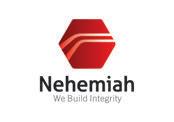
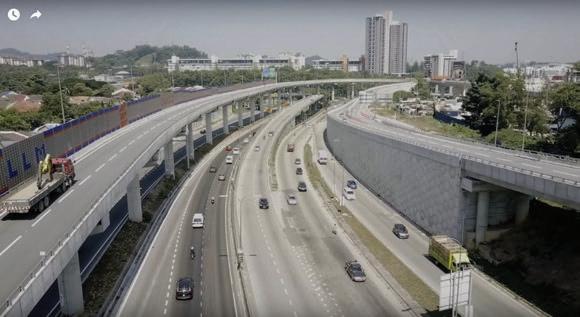
Hydrogen storage and transportation modes are influenced by several factors, such as distance and quantity as well as cost considerations. For instance, for intercontinental transportation, one common mode is the use of liquid hydrogen or liquid organic carrier, which allows efficient longdistance shipment. On the other hand, for transportation within a country or region, options such as interstate pipelines can be employed. For short distance transportation, trucks and railways can serve as practical modes of transport. These are just a few examples of the various storage and transportation modes.
The statistics on greenhouse gases emission by sectors in the Intergovernmental Panel on Climate Change (IPCC), AR6 Synthesis Report: Climate Change 2023 report, shows that the use of fossil fuel as energy sources contributes to 78% of the total emissions in the Asia Pacific region[3] This covers various sectors such as building (5%), electricity/heat (38%), fugitive emissions (7%), manufacturing/construction (17%), transportation (10%) and other fuel combustion (1%). The projection based on the statistics indicates that without mitigation measures towards reducing carbon dioxide emissions, overall emissions will increase from near to 30 GtCO2e (2019) to 39.3 GtCO2e (2030) in the region.
With adherence to the nationally determined contributions (NDCs) by each country involved in the Paris Agreement, it is projected that the emissions can be reduced slightly to 28.5 GtCO2e but this target is still far from the global call to cut 45% emissions by 2030. Malaysia has submitted a revised NDC in July 2021 to the United Nations Framework Convention on Climate Change (UNFCCC), with an unconditional target to reduce 45% carbon intensity against GDP by 2030 compared to 2005 level. In the first intended NDC, the unconditional emissions reduction target was 35%, with the additional 10% being conditional on external support[4]
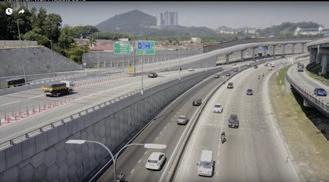

enquiry@nehemiah-grp.com
The key targeted sectors include energy, industrial processes, agriculture and land use, land-use change & forestry (LULUCF). In this regard, The Ministry of Natural Resources, Environment & Climate Change has reported recently that Malaysia’s renewable energy supply is now standing at 25% and that the target is to increase it to 31% and 40% by 2025 and 2035 respectively. To achieve this, the Malaysia Renewable Energy Roadmap, published by the Sustainable Energy Development Authority (SEDA) Malaysia in 2021, has identified 4 key technology-specific pillars including solar, bioenergy, hydro and new solutions and resources as the keys to decarbonise the electricity sector [2]. Herein, hydrogen as the energy storage solution has been identified as one of the new RE solutions to maintain system stability under high variable renewable energy (VRE) sources.
At the COP23 meeting in Bonn, the Hydrogen Council, a consortium of companies in the automotive, oil & gas, industrial gas and equipment industries, presented its vision of how hydrogen could contribute to achieving ambitious climate targets. It estimated that hydrogen could contribute around one-fifth of the total abatement need by 2050 if serious efforts were made to limit global warming to 2°C. This vision, while ambitious, would be feasible if policy makers, industry and investors stepped up efforts to accelerate the deployment of low-carbon technologies.
Hydrogen has the potential to play a significant role in achieving deep decarbonisation across various industries. According to Hydrogen Europe, 55% of global hydrogen consumption is used for ammonia production, 25% for petroleum refining, 10% for methanol production and the remaining 10% for energy applications (such as fuel cell vehicles), food, metalworking, medical, materials processing and others[5]. While traditional methods for hydrogen production (such as steam reforming of natural gas and other light hydrocarbons, partial oxidation of heavier hydrocarbons and coal gasification) emit a carbon footprint and require electricity from the electric grid, the adoption of green hydrogen production processes can lead to a reduced reliance on high-carbon footprint hydrogen. This enables the decarbonisation of end-use applications using hydrogen. In general, these four main areas include:
1. Transportation.
2. Industrial energy uses.
3. Building heat and power.
4. Chemical feedstock.
At present, electrolysis is the sole feasible route to produce green hydrogen [6]. This process uses electricity to split water into hydrogen and oxygen. If the source of electricity used is from renewable energy sources such as wind, solar or hydro power, the hydrogen produced is labelled green hydrogen. Figure 2 shows the overview of deep decarbonisation of various sectors with hydrogen. In the transportation sector, hydrogen can be used as fuel to power motor vehicles. These vehicles run on fuel
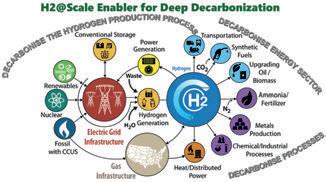
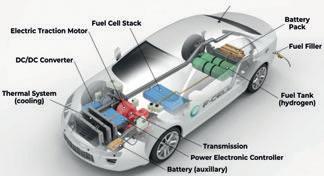
cells which provide power to the motor by continuously feeding hydrogen to the fuel cell, generating direct current and power from the electrochemical reaction (Figure 3). The only by-products of this process are water vapour and heat. One main advantage of hydrogen fuel cell electric vehicles (FCEVs) is quick refuelling time and long driving distance range as compared to battery electric vehicles.
While it is difficult to predict when hydrogen-powered motor vehicles will become an affordable option, technological advancements are bringing them closer to widespread use. Car manufacturers are making efforts to advance fuel cell technology and ambitious targets have been set by national policies in China and Japan, leading many people to believe that hydrogen adoption will begin with the transportation sector (Figure 4).
The commercialisation of hydrogen vehicles has already started with passenger cars, while hydrogen buses are becoming more popular in response to growing concerns over local pollution. Ambitious national targets, such as having 1.8 million FCEVs on the roads in China and Japan by 2030, can increase momentum for the adoption of hydrogen-powered vehicles in the transportation sector. South Korea plans to convert 26,000 buses to hydrogen use and Shanghai plans to purchase and operate 3,000 fuelcell buses by 2020. Vans and minibuses will also benefit from stricter regulations on delivery vehicles and other commercial fleets.
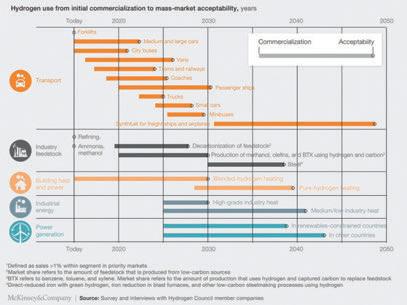
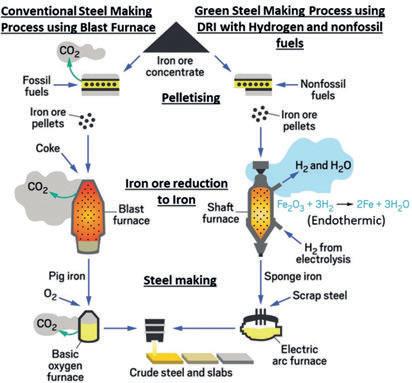




enquiry@nehemiah-grp.com
Trucks that carry heavy payloads over long distances are another priority segment. With long ranges and defined routes, they may require less infrastructure; some estimates suggest that 350 filling stations will cover the whole of the United States. Established manufacturers such as Toyota and start-ups like Nikola Motors have started building heavy-duty and long-haul trucks to capture opportunities in the booming freight-transport industry.

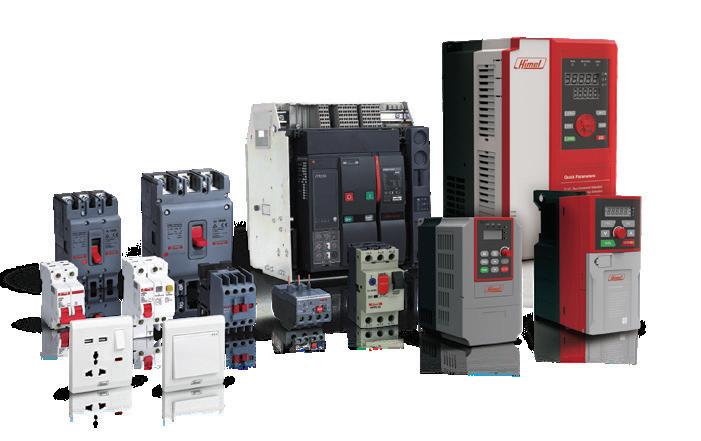

Clean hydrogen can help decarbonise hard-to-abate industries such as steel, cement and chemicals which cannot be directly electrified using renewable power. These industries rely heavily on fossil fuel for high-temperature energy or chemical feedstocks, resulting in a significant contribution to annual CO2 emissions worldwide. They are also among the most difficult to decarbonise, due to technical and economic factors. Steel and cement production can be decarbonised by installing carbon capture and storage (CCS) equipment or switching to processes or fuels (such as hydrogen) that can have zero or low emissions. In the steel industry, hydrogen can be used as an energy source to replace coal to reduce iron ore in steel making process (Figure 5). This process can reduce the energy consumption with much lower temperatures compared to the conventional blast furnace method. Hydrogen can be used in existing direct reduction iron (DRI) furnaces which operate with syngas from natural gas. With the blending of green hydrogen or as a complete replacement in feed gas, it can reduce the carbon footprint in steel making, thereby facilitating the production of green steel. The decarbonisation of the steel industry will be a huge contribution to the decarbonisation of the car making industry. On average, 900 kg of steel is used per car, which means substituting existing steel with green steel can further reduce the overall carbon footprint.
Hydrogen can be used in cogeneration units to generate both heat and power for industrial uses. In regions with established natural gas networks, hydrogen can be a cost-effective solution for the decarbonising heat process. Green hydrogen can be used to produce chemicals with a lower carbon footprint. Green ammonia, produced from green hydrogen, can play a key role in the decarbonisation of the agricultural sector and serve as a hydrogen carrier and fuel. Green ammonia enables the transporting of hydrogen at relatively low cost by densifying it using well-understood technologies. This makes it an attractive option for storing and transporting hydrogen for use in various applications, including as a fuel for heavy transport such as shipping. The interplay between green ammonia as a fertiliser source and hydrogen carrier has the potential to contribute to decarbonisation efforts.


One of the main advantages of using electrolysis for green hydrogen production is its scalability. Electrolysis systems can be designed to produce hydrogen at various scales, from small-scale systems for local use to largescale systems for industrial applications. This flexibility allows for the deployment of electrolysis systems for on-site hydrogen production.
As the share of RE in the electricity mix continues to grow, the potential for green hydrogen production through electrolysis increases with potential cost reduction. Nonetheless, the key challenge to achieving renewable electricity capacity rise of more than 60% from 2020 to 2026 (over 4800 GW) to meet decarbonisation targets, lies with the intermittent nature of different renewable sources [11]. One way to address the challenge of decarbonisation is through the use of Power-to-X (PtX) technology, which enables indirect electrification through sector coupling [12]. This approach involves using affordable RE sources such as photovoltaic, wind and hydropower, to directly power end-use applications like Power-to-Heat or Power-to-Energy Carriers, without relying on the grid.
In the context of decarbonisation with hydrogen, RE can be coupled with hydrogen production via electrolysis (Power-to-Gas). This allows for localised or on-site hydrogen production when coupled with available RE sources at a specific location. The hydrogen can then be used as feedstock to produce carbonneutral energy carriers (hydrogen derivates). PtX technologies can facilitate sector coupling by integrating the electricity sector with other sectors such as industry and transport. This can be achieved through direct electrification from renewable energies to power industrial processes via power-to-gas (PtG)


enquiry@nehemiah-grp.com
or power-to-liquid (PtL). This can help increase the overall utilisation of RE and reduce reliance on fossil fuels for energy production. One key benefit of this approach is that it can be designed to balance the intermittent nature of RE sources and improve the overall efficiency and cost-effectiveness of the energy system. For instance, excess renewable electricity can be used to produce hydrogen through electrolysis, which can then be used in other sectors such as transport or heating.
In the aviation and marine transportation sectors, PtX technology can be used to produce green fuel on-site by coupling with available RE sources. This allows sustainable fuels to be produced in these sectors. This concept will enable the economic feasibility of hydrogen production where high electrical tariff remains the main hurdle for cost-effective hydrogen production.
In summary, with no “silver bullet solution in the race to net-zero emissions by 2050, aggressive efforts in all aspects, including technology improvement, cost effectiveness and innovation on new business and financial models, are required simultaneously to create a feasible hydrogen economy worldwide.
[1] Miao Yang, Ralf Hunger, Stefano Berrettoni, Bernd Sprecher, Baodong Wang. A review of hydrogen storage and transport technologies. 2023. Clean Energy 7(1), 190-216. https://doi.org/10.1093/ce/zkad021
[2] SEDA Malaysia, “Malaysia Renewable Energy Roadmap: Pathway towards Low Carbon Energy System, 2021. https://www.seda.gov. my/reportal/wp-content/uploads/2022/03/MyRER_webVer3.pdf (accessed June 9, 2023)
[3] “AR6 Synthesis Report: Climate Change 2023, Intergovermental Panel on Climate Change (IPCC)” https://www.ipcc.ch/report/ar6/syr/ (accessed June 9, 2023)
[4] United Nations Climate Change, “Nationally Determined Contributions Registry” https://unfccc.int/NDCREG (accessed June 12, 2023)
[5] Hydrogen Europe, “COP26 Special Hydrogen Report” https:// hydrogeneurope.eu/in-a-nutshell/reports/ (accessed June 12, 2023)
[6] IRENA, “Green Hydrogen Supply: A Guide to Policy Making, International Renewable Energy Agency, 2021. https://www.irena. org/-/media/Files/IRENA/Agency/Publication/2021/May/IRENA_ Green_Hydrogen_Supply_2021.pdf (accessed June 9, 2023)
[7] Department of Energy, U.S. “U.S. National Clean Hydrogen Strategy and Roadmap” https://www.hydrogen.energy.gov/pdfs/us-nationalclean-hydrogen-strategy-roadmap.pdf (accessed June 12, 2023)
[8] Department of Energy, U.S. “How Do Fuel Cell Electric Vehicles Work Using Hydrogen?” https://afdc.energy.gov/vehicles/how-dofuel-cell-electric-cars-work (accessed June 9, 2023)
[9] Bernd Heid, Martin Linder, Anna Orthofer Markus Wilthaner, “Hydrogen: The next wave for electric vehicles?” https://www.mckinsey.com/ industries/automotive-and-assembly/our-insights/hydrogen-the-nextwave-for-electric-vehicles#/ (accessed June 9, 2023)
[10] Mark Peplow. “Chemical & Engineering News: Can industry decarbonize steel making?” https://cen.acs.org/environment/green-chemistry/steelhydrogen-low-co2-startups/99/i22 (accessed June 9, 2023)
[11] Tom Terlouw, Christian Bauer, Russell McKenna, Marco Mazzotti. 2023. Large-scale hydrogen production via water electrolysis: a technoeconomic and environmental assessment. Energy & Environmental Science 15, 3583-3602. https://doi.org/10.1039/D2EE01023B
[12] Matthew J. Palys & Prodromos Daoutidis. 2022. Computers & Chemical Engineering 165, 107948. https://doi.org/10.1016/j. compchemeng.2022.107948
D EEPE ST
CO ND OLE NC ES
On behalf of
The Institution of Engineers Malaysia (IEM), we would like to express our deepest condolence to the bereaved family of Ir. Yong Kee Chiang on his sudden passing.
We at IEM, honour his contribution to IEM as IEM Council Member Session 1988, 1989 & 1990 and External Auditor & Honorary Internal Auditor Session 1999.
May he rest in peace.
Smart & Sustainability Cities Engineering Symposium (SSCES 2023) - Advancing the Future of Smart and Inclusive Developments
Date : 9 September 2023 (Saturday)
Time : 9.00 a.m. - 5.30 p.m.
Venue : Kuala Lumpur Convention Centre (KLCC) & Online Platform
Approved CPD : 6
Speakers : Ir. Habibie Razak
: Ts. Dr Raslan Ahmad
: Dr Xiaohua Chen
: Mr. Derek Foong
: Ir. Mohd Razif Abd Halim
: Ts. Dr Foo Chee Hung
: EUR ING Ir. Dr Lam Wei Haur
: Dr Lim Seng Boon
Project Management Conference 2023 - Advancing Project Management - Agile and Beyond 2023
Date : 9 September 2023 (Saturday)
Time : 9.00 a.m. - 5.00 p.m.
Venue : Kuala Lumpur Convention Centre (KLCC) & Online Platform
Approved CPD : 6
Speakers : Datuk Seri Norazlan Mohd Razali
: Datuk Ir. Mohd Idris Abdullah
: Dr Kassim Noor Mohamed
: Ir. Dr Hannerita Mohamad Zainal
: Ir. Mohd Adha Desa
: Mr. Mohd Azra Ahamad
: Mr. Abhinand Pillay
: Ir. Yusrizal Mohd Yusof
: Mr. Ahmad Sharifuddin Ismail
: Mr. Achmat Nadhrain Ibrahim
5-Day IEM Energy Manager Training Course (EMTC)
- A Preparation Course for Registration as a Registered Electrical Energy Manager (REEM) with Suruhanjaya Tenaga
Date : 11 - 15 September 2023 (Monday - Friday)
Time : 8.30 a.m. - 5.30 p.m.
Venue : Wisma IEM
Approved CPD : 33
Speakers : Ir. Francis Xavier Jacob
: Ir. Assoc. Prof. Dr Gobbi Ramasamy
: Ir. Luk Chau Beng
: Ir. Gopal Narian Kutty
: Ir. KT Lim
: Ir. Chong Chew Fan
: Ir. Al Khairi Mohd Daud
: Ir. Tan Jin Kiong
Webinar Talk on Agile Project Management
Date : 14 September 2023 (Thursday)
Time : 3.00 p.m. - 5.00 p.m.
Venue : Online Platform
Approved CPD : 2
Speaker : Assoc. Prof. Dr Abd Rahman bin Abdul Rahim
(IEM PENANG BRANCH) For further enquiries on the events below, please visit the IEM Penang branch website at http://iempenang.org or contact Ms. Julie at 04-6065998.
Decentralised Water / Wastewater Treatment Systems
– Could it be a Potential for Water Security?
Date : 15 September 2023 (Friday)
Time : 6.00 p.m. - 8.00 p.m.
Venue : Online Platform
Approved CPD : 2
Speaker : Assoc. Prof. Dr Poh Phaik Eong
Fueling the Mind: The Impact of Nutrition on Cognitive Performance, Creativity, and Well-Being
Date : 16 September 2023 (Saturday)
Time : 10.00 a.m. - 11.00 a.m.
Venue : Online Platform
Speaker : Johnathan Chew
A Quick Guide to BEM Professional Competency Examination for Air Conditioning & Mechanical Ventilation System
Date : 25 September 2023 (Monday)
Time : 8.30 a.m. - 5.30 p.m.
Venue : Penang Secretariat Office
Approved CPD : 7
Speaker : Ir. Ng Yong Kong
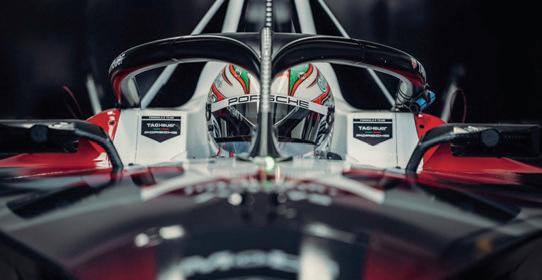
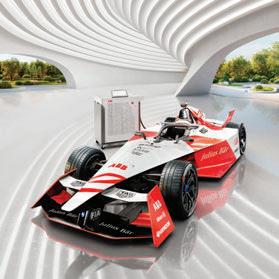

Written and Prepared by:

Ir. Shamila Ariaratnam
Honorary Secretary/Treasurer of EETD and Advisor to the Healthcare and Biomedical Engineering Working Group, she has served as an engineer for various industries with the last 16 years in the healthcare industry.
Hydrogen, the lightest and most abundant element in the universe, has a long history of usage as an energy source. From ancient times to the modern era, humans have recognised the potential of hydrogen as a versatile and clean fuel.
The history of hydrogen dates back to ancient times, although its true nature as an element was not fully understood until much later. In 1766, English chemist Henry Cavendish isolated hydrogen gas and identified it as a distinct element1. His work laid the foundation for further studies and experiments on the properties of hydrogen.
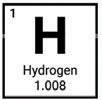
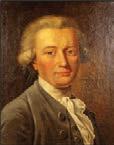
By the 19th century, scientists had recognised the potential of hydrogen as a source of energy 2 .
During the Industrial Revolution (18th-19th century), hydrogen began to play a significant role. One notable application was the use of hydrogen gas in lighting to illuminate streets and buildings in cities around the world. Hydrogen also found applications in metallurgy, where it was used in the process of removing impurities from metal ores 2 .
The space race of the mid-20th century sparked a renewed interest in hydrogen as a propulsion fuel. In 1956, the United States launched the first liquid hydrogen-fuelled rocket, ushering in a new era in space exploration. Hydrogen’s high energy density and clean combustion characteristics made it an ideal choice for rocket engines, powering missions to the moon and beyond. The use of hydrogen in the space industry not only advanced space exploration but

Ir. Jeewa Vengadasalam
IEM Council member (2020-2023) and former Chairman of EETD, Ir. Jeewa was a former Deputy Director of the Ministry of Communication & Digital and later, part of Universiti Tunku Abdul Rahman’s Academic staff.
also contributed to the development of hydrogen-related technologies and infrastructure 2 .
In recent decades, hydrogen gained renewed attention as a potential solution to global energy challenges, particularly in the context of reducing greenhouse gas emissions and the transition to clean energy sources. The concept of using hydrogen as a fuel for fuel cells emerged in the 19th century, but it was not until the late 20th century that significant advancements were made in fuel cell technology 3. Fuel cell vehicles which used hydrogen as a fuel to produce electricity, were developed and deployed in several countries as a clean alternative to conventional vehicles. When consumed in a fuel cell system, hydrogen produces only water as its by-product. Instead of greenhouse gases which are harmful to the environment, hydrogen-powered fuel cell vehicles emit only water vapour from the tailpipes.
Today, as the world hungers for new and more sustainable forms of energy, hydrogen has been on a steady climb to the top. Two of the most common methods of producing hydrogen are steam-methane reforming and electrolysis (splitting water with electricity). The production of hydrogen through electrolysis was first carried out in 1800 by English scientists William Nicholson and Sir Anthony Carlisle who applied an electric current to water to produce hydrogen and oxygen gases 4 .
Electrolysis itself does not produce any by-product or emissions other than hydrogen and oxygen. The electricity required for electrolysis is usually provided by the electric power grid which is supplied by a mix of renewable sources, nuclear energy and fossil fuels. In steam-methane reforming, high-temperature steam (700°C to 1,000°C) under 3 bar to 25 bar pressure (1 bar = 14.5 pound per square inch) is reacted with methane in the presence of a catalyst to produce hydrogen, carbon monoxide (CO) and carbon dioxide (CO2 ) 5 .
Other methods of hydrogen production that are still very much in their infancy stages include the conversion of biomass into gas or liquids and to separate the hydrogen produced, photolytic processes that use solar energy to split water into hydrogen and oxygen as well as the use
of microbes such as bacteria and microalgae to produce hydrogen through biological reactions 5
Does Hydrogen have a Carbon Footprint?
Although hydrogen-powered cars operate with zero emissions, producing hydrogen as a fuel can be a very different story. As the earth’s most abundant element, hydrogen is found everywhere, from fossil fuels to water to plants, but it never appears naturally in its pure form.
Procuring hydrogen requires it to be separated from other elements through chemical processes and these require energy. These processes create varying degrees of environmental pollutants. There are 3 main categories of hydrogen: grey, blue and green 6 .
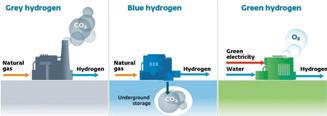
Grey hydrogen is derived from natural gas and produced from fossil fuels, making it the least renewable form of hydrogen. Most of the hydrogen produced today is grey hydrogen. It is relatively inexpensive and is commonly used in the chemical industry to make fertilisers and for refining oil. Grey hydrogen is produced by reforming natural gas, a processing technique used to rearrange the molecular structure of hydrocarbons. In this process, methane (the primary element in natural gas) is mixed with steam at a high temperature to yield hydrogen and carbon dioxide through a catalytic chemical reaction. Unfortunately, for every 1kg of hydrogen produced, almost 10kg of carbon dioxide is released into the atmosphere. The overall impact of grey hydrogen on the climate is, therefore, negative.
Blue hydrogen is produced in much the same way as grey hydrogen; the difference is in the manner in which the carbon dioxide produced is managed. With blue hydrogen, the carbon dioxide produced is captured at the production facility and stored separately. But the storage, known as Carbon Capture & Storage (CCS) technology, is costly and poses logistical challenges. The blue hydrogen process does not eliminate carbon emissions into the atmosphere entirely but is more ecologically friendly than grey hydrogen.
Green hydrogen is closer to viable sustainability. The technique employed to produce green hydrogen is electrolysis of water to separate hydrogen and oxygen molecules. Renewable sources such as wind and solar power are used to generate the electricity needed for the electrolytic process.
Utilising renewable sources instead of fossil fuels is the key to making green hydrogen. This technique yields
a closed loop of sustainable energy in which no harmful gases are produced at any point in the production chain, making it the ultimate goal in the production of hydrogen with minimal carbon footprint.
Although green hydrogen appears to be the ideal alternative as an energy source, its production is not without challenges. The machinery required for electrolysis is costly and clean electricity from solar and wind sources is limited in supply. The environmental advantages of green hydrogen are potentially far-reaching, but producing this clean energy source is yet to be practical.
Although hydrogen may play a significant role in a clean energy future, there is still a long way to go. To reach its zero-emissions potential, there will need to be a gradual shift from grey hydrogen to green hydrogen in the years ahead. How long this will take and its overall feasibility are as yet unknown.
As the world grapples with the urgent need for sustainable and clean energy sources, hydrogen has emerged as a promising solution that can transform various sectors, from transportation to power generation. Governments and industries around the globe are engaged in a fierce competition to become leaders in the hydrogen energy race. Four countries stand out from the rest of the world in harnessing the power of hydrogen.
Germany, a renowned leader in renewable energy, has positioned itself at the forefront of the hydrogen revolution7. Its government has adopted an ambitious hydrogen strategy, backed by substantial investments and policy support. Germany’s focus lies primarily in green hydrogen, produced through electrolysis powered by renewable energy sources. The country aims to become a global exporter of clean hydrogen and has initiated numerous pilot projects and partnerships with industry leaders to realise this vision. Its commitment to green hydrogen is evident in the establishment of hydrogen clusters, research institutes and the development of numerous hydrogen infrastructures. Furthermore, Germany’s car industry has embraced fuel cell technology, driving innovation and adoption in the transportation sector.
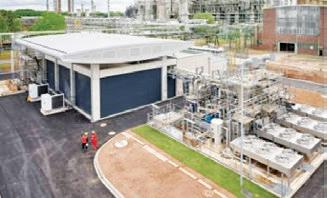



The BH Girder is an innovative and enhanced version of PSC Girder that utilizes the Bulb-T shape integrated with Half Slab which enables it to be applied over a span of longer than 60m. By adopting the latest cutting-edge technologies and innovati on, the BH Gir der has been designed to achieve the ultimate goals of “ Cost Effectiveness ”, “ Rapid Construction”, “Aesthetics” and “Safety”.



ciency


● Maximization of prestressing efficiency
● Minimization of prestressing friction loss
● Reduction of substructure cost
● Reduction of slab cost by half slab girder
● Omission of deck slab form work and s hori ng work by half slab girder
● Shorter construction period

● Design computations and analysis
● Construction drawings
● Material and c onstruction specifications
● Cost estimates
● Technical advice and c onstruction
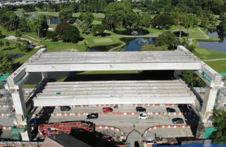


Tel : 012 218 6693( Tan CC) Tel : 603 6142 6638
Fax : 603 6142 6693
Email : tancc@nehemiah-grp.com
Email : enquiry@nehemiah-grp.com


Japan has long recognised the potential of hydrogen to address energy security and sustainability concerns. Its government has set ambitious targets to create a “hydrogen society” by 2030 9 and its comprehensive approach involves investing in hydrogen infrastructure, promoting fuel cell technology and supporting research and development. Japan has been actively developing hydrogen supply chains, including importing hydrogen from abroad, to meet its growing demand. When it hosted the Tokyo Olympics in 2020, it showcased its commitment to hydrogen by utilising fuel cell technology to supply power for the event. Furthermore, its car industry is a pioneer in fuel cell vehicles, contributing to the expansion of hydrogen infrastructure and fostering technological advancements.
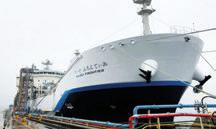
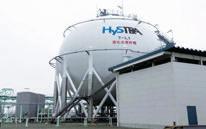
China, the world’s largest emitter of greenhouse gases, is also the world’s biggest producer of hydrogen. It recognises the transformative potential of hydrogen in its efforts to combat climate change. The Chinese government has launched an aggressive hydrogen strategy with a focus on scaling up hydrogen production and infrastructure 11. Its approach encompasses both green and blue hydrogen production, leveraging on its vast renewable energy capacity and natural gas reserves. The nation is investing heavily in research and development, fuel cell technology and hydrogen storage systems. Additionally, China’s manufacturing capabilities enable it to mass produce hydrogen-related technologies and equipment, contributing to cost reductions and market scalability. Its commitment to hydrogen is further demonstrated by the development of hydrogen-powered vehicles and the integration of hydrogen in industrial sectors.
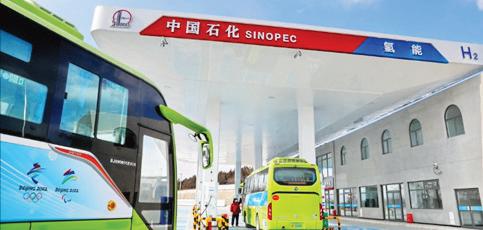
The United States has recently intensified efforts to catch up in the global hydrogen energy race13. The Biden administration has made hydrogen a key component of its clean energy agenda, proposing substantial investments in research, development and deployment. The US boasts of a robust foundation in fuel cell technology, with numerous innovative companies and research
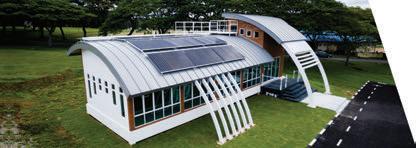


institutions. The abundance of natural gas reserves positions it favourably for blue hydrogen production as an interim solution while green hydrogen capacities are developed. Moreover, the US has implemented initiatives to foster collaboration between the public and private sectors, driving innovation and accelerating the adoption of hydrogen in various industries.
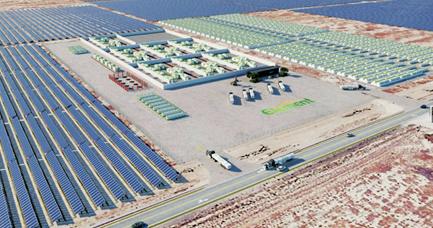
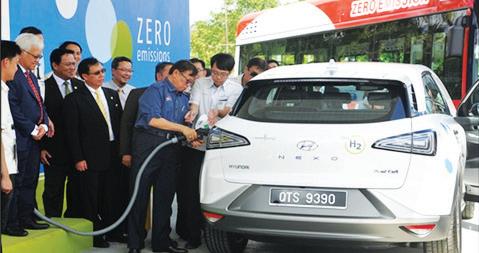
and economic growth. At its heart is the Autonomous Rapid Transit (ART) which will be the backbone of the public transport system transformation. Moving at 70km/h on rubber tyres, the ART is a trackless articulated hydrogen fuel cell electric vehicle running on dedicated lanes. The first ART vehicle, manufactured in China and acclaimed as the world’s first hydrogen-powered tram, is on its way from its production site in Hunan province to Kuching where it will be a prototype for the KUTS 23 .
Hydrogen in Malaysia
Malaysia’s foray into hydrogen energy began in 2001 when it identified hydrogen fuel cells as a priority research area and funds were allocated for its research16. Subsequently, a hydrogen road map was formulated in 2006 and in 2017, a blueprint for fuel cell industries in Malaysia was published17. The National Energy Policy (2022–2040)18, formulated in September 2022, further reiterated the importance of hydrogen as a potential growth opportunity for production and export with a long-term goal to become an export hub for green hydrogen.
Sarawak, blessed with abundant supply of natural gas and a topography that provides it with a competitive edge in the production of hydroelectricity at lower electricity tariffs, has led the nation in bringing to fruition many of the country’s hydrogen aspirations19
In 2017, Sarawak Energy Bhd., in collaboration with Linde EOX Sdn. Bhd., began construction work on Malaysia’s first integrated green hydrogen production plant and refuelling station. Located in Kuching and completed in 2019, the plant can produce 130kg of hydrogen per day at a purity level of 99.999% and is capable of supporting and fully refuelling up to 5 fuel cell buses and 10 fuel cell cars per day 20
Subsequently, 3 hydrogen-powered electric buses were introduced in Kuching in 2019 21. Imported from China, the red and white coloured buses have the words “Zero Emission and Hydrogen Bus” prominently displayed and passengers can ride these buses for free.
In July 2022, Sarawak implemented the Kuching Urban Transportation System (KUTS) Project 22. Sarawak Metro was tasked with implementing the KUTS, aimed at minimising traffic congestion in the city while spurring productivity
In the offing are 3 more green hydrogen production plants complete with export facilities. Located in Bintulu, they are developed by the Sarawak Economic Development Corporation (SEDC) in collaboration with a consortium of multinational companies. They are expected to be operational between 2024 and 2028. Ranking first among the projects is the SEDC, H2X Global Limited and Thales New Energy consortium which is expected to produce 170,000 tons of green hydrogen annually and will come on stream in 2024 24. Following closely are the
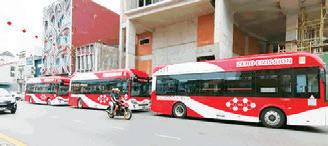
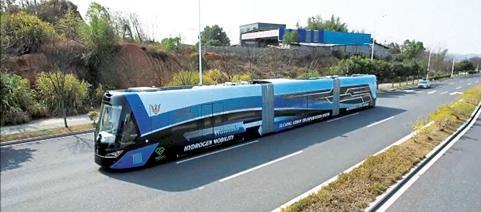
H2biscus and H2ornbill projects. Jointly developed by SEDC, South Korea’s Samsung Engineering, Lotte Chemicals and Posco Holdings, the H2biscus project is expected to produce 7,000 tons of green hydrogen annually from hydroelectric power in 2027 25. For the H2ornbill project, where SEDC partnered with Japanese firms Eneos Corporation and Sumitomo Corporation, a target of 10,000 tons annually of green hydrogen production from hydroelectric power is anticipated in 2028 26 .
However, Sarawak faces many challenges in its aspiration to become a leader in hydrogen economy. Several obstacles stand in the way of its transition to fully embracing a hydrogen economy. So far, its use of hydrogen in hydrogen-powered buses and cars is but on a small scale. Presently, commuters ride for free on these hydrogen buses. While the free rides help to raise awareness of clean fuel usage and decarbonising the environment, the burning question is whether commuters will be willing to pay the hefty fares once the free rides are revoked. In addition, hydrogen-driven electric buses and passenger cars are expensive as they are imported. Cheaper alternatives presented by battery fuel cells further complicate the challenges posed. Thus, hydrogen presents itself as a double-edged sword. Hydrogen solutions may be technically viable but will they make economic and commercial sense to support the transition from a fossil fuel-based economy?
Deriving energy from combusting hydrocarbons has been the norm for mankind but the vast majority of world leaders have pledged to decarbonise their economies between 2030-2050 27. As the world grapples for solutions to the problem of decarbonisation, hydrogen presents itself as a promising candidate but intricate questions surface. Can hydrogen unleash the same energy required to smelt steel and produce cement without combusting hydrocarbons? Can it power aircrafts flying at blistering speeds and phenomenally dizzying heights? What about the power that goes into propelling colossal container ships and cruise liners or mankind’s various intergalactic aspirations?
The race for hydrogen energy supremacy is a dynamic and evolving competition, with each country bringing unique strengths and strategies to the table. Germany’s pioneering efforts in green hydrogen, Japan’s comprehensive approach to building a hydrogen society, China’s aggressive scale-up of hydrogen production and the USA’s focus on innovation and collaboration all contribute to the intensity of the race. The progress of each country varies in different aspects of the hydrogen value chain. However, the collaborative efforts and advancements made by these countries collectively signify a significant global shift towards a hydrogen-powered future. The race for hydrogen energy dominance will likely continue, with countries collaborating and learning from each other to overcome challenges and unlock the immense potential of hydrogen as a sustainable energy source.
According to the World Energy Council 28, hydrogen demand will grow at a moderate, steady pace up until 2030 with accelerated growth forecasted beyond 2035 as new applications emerge across the industrial, transport, energy and buildings sectors via inter and intra country collaborations. These cross-sector collaborations are anticipated to steadily decrease the cost of hydrogen production until 2050.
Affordable production costs will enable countries with limited renewable resources and densely populated regions stifled by land constraints, to import green hydrogen. In turn, this will result in export and import hubs developing around the world, similar to the current oil and gas hubs, but with new players in hydrogen supply.




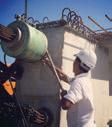
Nehemiah-OVM provides the following products and services:
- Post-tensioning solution provider
- Carpark Flat Slab
- Transfer Plate
- Beams, Box Girders
- Alternative design solutions
- Cable systems (stay cable, main cable, hanger)
- Bridge bearing and expansion joint
- Construction solutions (heavy lifting, ILM, etc)
- Monitoring, repairing and strengthening for structures




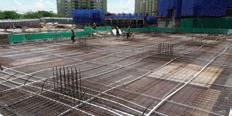
The Strand, Kota Damansara 47810 Petaling Jaya
Selangor Darul Ehsan
Tel : 603 6142 6638
Fax : 603 6142 6693

Email : enquiry-pt@nehemiah-grp.com

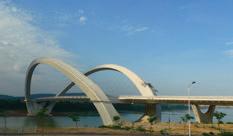
[1] Encyclopaedia Britannica, Henry-Cavendish (2023), https://www. britannica.com/biography/Henry-Cavendish. Accessed on 28 June 2023.
[2] Altenergymag.com, The History of Hydrogen (2009), https://www. altenergymag.com/article/2009/04/the-history-of-hydrogen/555/. Accessed on 28 June 2023.
[3] WIPO Magazine, Green Technologies: Electric Cars with Hydrogen Fuel Cells (2009), https://www.wipo.int/wipo_magazine/en/2009/02/ article_0009.html#:~:text=It%20was%20a%20Welsh%20 physicist,water%20as%20a%20by%2Dproduct. Accessed on 28 June 2023.
[4] Carnotcycle, Carlisle, Nicholson and the discovery of electrolysis (2017), https://carnotcycle.wordpress.com/2017/02/01/carlisle-nicholson-andthe-discovery-of-electrolysis/. Accessed on 28 June 2023.
[5] US Energy Information Administration, Production of hydrogen (2023), https://www.eia.gov/energyexplained/hydrogen/productionof-hydrogen.php#:~:text=The%20two%20most%20common%20 methods,hydrogen%20production%20methods%2C%20or%20 pathways. Accessed on 28 June 2023.
[6] Petro Online, What is the Difference Between Blue and Green Hydrogen? (2023), https://www.petro-online.com/news/fuel-forthought/13/international-environmental-technology/what-is-thedifference-between-blue-and-green-hydrogen/. Accessed on 3 July 2023.
[7] Center for Strategic & International Studies (CSIS), Germany’s Hydrogen Industrial Strategy (2021), https://www.csis.org/analysis/ germanys-hydrogen-industrial-strategy. Accessed on 11 July 2023.
[8] Shell Global, Shell starts up Europe’s largest PEM green hydrogen electrolyser (2021), https://www.shell.com/media/news-and-mediareleases/2021/shell-starts-up-europes-largest-pem-green-hydrogenelectrolyser. Accessed on 11 July 2023.
[9] We Are Tomodachi, Creating a “Hydrogen Society” to Protect the Global Environment (2017), https://www.japan.go.jp/tomodachi/2017/ spring-summer2017/creating_a_hydrogen_society. Accessed on 11 July 2023.
[10] Reuters, Insight: Too cold to handle? Race is on to pioneer shipping of hydrogen (2021), https://www.reuters.com/business/sustainablebusiness/too-cold-handle-race-is-pioneer-shipping-hydrogen. Accessed on 11 July 2023.
[11] Center for Strategic & International Studies (CSIS), China’s Hydrogen Industrial Strategy (2022), https://www.csis.org/analysis/ chinas-hydrogen-industrial-strategy. Accessed on 11 July 2023.
[12] China Daily, China looks to clean hydrogen fuel to power future (2022), https://www.chinadaily.com.cn/a/202205/18/ WS628458d0a310fd2b29e5d70bl. Accessed on 11 July 2023.
[13] US Department of Energy, Biden-Harris Administration Releases First-Ever National Clean Hydrogen Strategy and Roadmap to Build a Clean Energy Future, Accelerate American Manufacturing Boom (2023), https://www.energy.gov/articles/biden-harris-administrationreleases-first-ever-national-clean-hydrogen-strategy-and. Accessed on 11 July 2023.
[14] Spectrum News 1, Green hydrogen plant in Lancaster will be one of California’s largest (2023), https://spectrumnews1.com/ca/la-west/ environment/2023/01/24/green-hydrogen-plant-in-lancaster-will-beone-of-ca-s-largest. Accessed on 11 July 2023.
[15] Sumitomo Corporation, Partnership agreement on hydrogen use and community development concluded between Namie Town (Fukushima Prefecture) and Sumitomo Corporation (2021), https:// www.sumitomocorp.com/en/jp/news/release/2021/group/14310. Accessed on 11 July 2023.
[16] The Edge Malaysia, Cover Story: Is Malaysia ready for the hydrogen economy? (2021), https://theedgemalaysia.com/article/cover-storymalaysia-ready-hydrogen-economy. Accessed on 17 July 2023.
[17] Akademi Sains Malaysia, The Blue Print for Fuel Cell Industries in Malaysia (2017), https://www.akademisains.gov.my>asmpub. Accessed on 17 July 2023.
[18] Economic Planning Unit, Prime Minister’s Department, National Energy Policy, 2022-2040 (2022), https://www.ekonomi.gov.my/sites/ default/files/2022-09/National%20Energy%20Policy_2022_2040. pdf. Accessed on 17 July 2023.
[19] Malaysian Investment Development Authority (MIDA), Transforming Sarawak into a green economy (2023), https://www.mida.gov.my/ mida-news/transforming-sarawak-into-a-green-economy/. Accessed on 17 July 2023
[20] Bernama, Sarawak launches ASEAN’s first integrated hydrogen production plant (2019), http://energy.bernama.com/news. php?id=1730169. Accessed on 17 July 2023.
[21] The Borneo Post, Malaysia’s first hydrogen buses make debut on Kuching streets (2019), https://www.theborneopost.com/2019/08/01/ malaysias-first-hydrogen-buses-make-debut-on-kuching-streets/. Accessed on 17 July 2023.
[22] Sarawak Metro, We’re Implementing a Plan that KUTS through Traffic (2022), https://www.mysarawakmetro.com/kuts. Accessed on 17 July 2023.
[23] The Malay Mail, ART: World’s first hydrogen-powered smart tram begins journey to Sarawak (2023), https://www.malaymail.com/news/ malaysia/2023/07/20/art-worlds-first-hydrogen-powered-smart-trambegins-journey-to-sarawak-video/80739. Accessed on 17 July 2023.
[24] Australian Manufacturing Forum, H2X, Thales to make green ammonia in Borneo (2021), https://www.aumanufacturing.com.au/ h2x-thales-to-make-green-ammonia-in-borneo. Accessed on 17 July 2023.
[25] PR Newswire, POSCO Holdings to cooperate with Samsung Engineering, Lotte Chemical, Sarawak Economic Development Corporation Energy, and Malaysian Sarawak Energy for Green Hydrogen Business (2022), https://www.prnewswire.com/ news-releases/posco-holdings-to-cooperate-with-samsungengineering-lotte-chemical-sarawak-economic-developmentcorporation-energy-and-malaysian-sarawak-energy-for-greenhydrogen-business-301625065.html. Accessed on 17 July 2023.
[26] SP Global, Japan’s ENEOS, Sumitomo, Malaysian SEDC Energy mull green hydrogen supply network (2020), https://www.spglobal. com/commodityinsights/en/market-insights/latest-news/electricpower/102320-japans-eneos-sumitomo-malaysian-sedc-energymull-green-hydrogen-supply-network. Accessed on 17 July 2023.
[27] IEA, Global Hydrogen Review 2022 (2022), https://www.iea.org/ reports/global-hydrogen-review-2022. Accessed on 24 July 2023.
[28] World Energy Council, Hydrogen on the Horizon: National Hydrogen Strategies (2020), https://www.worldenergy.org/assets/ downloads/Working_Paper_-_National_Hydrogen_Strategies_-_ September_2021.pdf?v=1646390984. Accessed on 24 July 2023.
Written and Prepared by:

We all need to feel safe in our daily lives. Due to the immense importance of the safety factor, it should be introduced to the younger generation, especially students. Most engineering curriculums in universities introduce safety-related courses in the third and/or fourth years. But since it is so crucial, it is best to introduce safety engineering as early as possible.
For the first time, Faculty of Chemical & Energy Engineering (FCEE) in Universiti Teknologi Malaysia (UTM), via Introduction to Engineering (ITE) 3-credit course, exposed first-semester chemical engineering students to problems related to safety in their daily lives in 2021. The idea was to provide an early introduction to the safety concept in life and work to the students and thus inculcate best practices when it comes to decision making associated with safety.
The teaching and learning process employed StudentCentred Learning (SCL) and Corporative Problem-Based Learning (CPBL) techniques. The process had successfully exposed students to various safety-related cases and motivated students to creatively solve or reduce specific safety problems.
In October that year, we introduced a new problem to the students, called Safety & Health 2021 (S&H 2021). There were 160 students from 5 sections and 10 lecturers facilitating the ITE course. On average, there were 32 students per section. The ITE course was integrated with Industrial Seminar & Profession (ISP) 1-credit and Introduction to Computer Programming (ICP) 3-credit courses.
For the record, the past CPBL projects had utilised sustainability-related problems since 2005. However,
safety and health-related problems were introduced in 2021 for the first time. The problem crafting design was begun 2 months before the semester by the ITE, ISP and ICP lecturers. Listed below are the authentic problems that have been used in the CPBL case for the last 8 years. The S&H theme was successfully used in 2021.
• 2014 –Water Sustainability Campaign 2014 (WASCAM2014)
• 2015– Energy Sustainability Awareness Campaign 2015 (ESAC2015)
• 2016 – Zero Waste Competition 2016 (ZWCS2016)
• 2017 – Trend & Fashion Campaign 2.0 (T&F 2.0)
• 2018 – Plastic Waste Awareness Campaign (PWAC2018)
• 2019 – Love our River Campaign 2019 (LORC2019)
• 2020 – Smart Consumerism Campaign 2020 (SCC2020)
• 2021 – Safety & Health 2021 Campaign (S&H2021)
The CPBL learning approach combines Cooperative Learning (CL) and Problem-Based Learning (PBL) techniques. It emphasises learning and problem-solving in small groups of 3-5 students. CPBL is designed for mediumsized classes of up to 60 students with one floating academic staff member or facilitator. The CPBL model consists of 3 stages and each stage has 3, all adapted to the constructivist approach.
The constructivist approach originates from the Constructivism Theory, which is an important learning theory based on the idea that learners build on their existing foundation to learn new information. Prior experiences in safety and health are regarded as the foundation for constructing meaningful real-world learning experiences so that engineering students will be
able to relate new knowledge with past experiences. The students’ possible safety and health experiences at home shall include but not be limited to the following:
• Painting hazard from organic odour/volatile solvent.
• Cooking with oxidised oil.
• Cooking utensils made from plastic.
• Air hazard from un-serviced air-conditioner.
• Drinking water from poorly maintained water filter.
• Walking/running on slippery floors/tiles.
• Switching on the light/power source using a wet hand.
• Poor electrical appliances/extension cable – electrical circuit problem.
• Cleaning the ceiling fan by using an unstable ladder. The S&H 2021 problem was revealed to the students in a Creative Package. There were 3 stages with increasing difficulty to build up the students’ knowledge and understanding. Stage 1 was about introduction and understanding as well as the benchmarking of safety and health. Stage 2 focused on data collection and analyses as well as comparing the data with selected international countries. Stage 3 was the engineering solution to the identified safety and health problem. In Stages 2 and 3, the learning processes involved computer programming basics to solve the given problem.
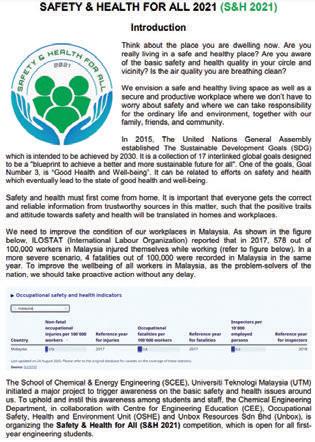
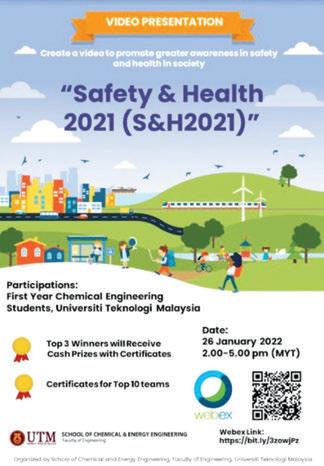
Finally, students presented their findings via a video (due to the Covid-19 pandemic situation) in an exhibition initiated by the FCEE, UTM under the ITE, ITCP and ISP firstyear courses.
The project was intended to trigger greater awareness, particularly among first-year chemical engineering students, of basic safety and health issues around us. The S&H 2021 exhibition solicited ideas from students to propose innovative sustainable solutions for solving and/ or improving health-threatening and unsafe conditions. The health and safety issues might not be visible to everyone but if we paid closer attention and care, we would realise there were so many unsafe behaviours/situations that could affect our physical health in the long run (chronic effect).
The ideas proposed in the S&H 2021 exhibition were intended to improve safety practices and health conditions as well as add value creation at home, university level and in the community. The inventions became a showcase of the best practices, not only for the students’ surroundings but also for Malaysia and the nearby regions and would bring competitive solutions to the market. More than 50 internal and external academic panellists, including industrial panellists, participated in the S&H 2021 exhibition. The head of the IEM Safety Engineering Special Interest Group (SESIG), Ir. Tajul Ariffin, was among those in the invited panellists.
Forty teams of students competed in 8 breakout rooms. The winners from each room and the Top 10 winners were judged based on specific criteria such as understanding of safety and health, creativity, communication, appreciation towards sustainability and others. Three examples of students’ video presentations can be viewed via the following links:
• https://www.youtube.com/watch?v=kowIMD9V8kQ&t=548s
• https://www.youtube.com/watch?v=v0kZIvAfiGE&t=5s
• https://www.youtube.com/watch?v=7BO7tho0AxQ&t=5s
Immediately after the exhibition, a survey form was distributed to get feedbacks from the panel members who had to rate the questions based on a simple Likert scale such as whether “students have creative ideas for the engineering solution regarding safety and health” and whether “students show understanding and engagement on safety and health”. About 50% of the panel members rated 4 (based on a Likert scale of 1 less likely to 5 most likely), indicating that they agreed on the students’ creative ideas as well as comprehension and engagement towards safety and health.
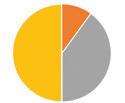
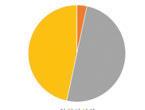
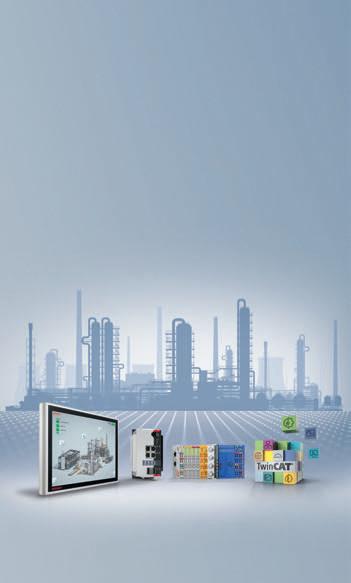
Positive feedback was received from the panel of evaluators. Some of the comments received are as follows:
• The programme is very good. Students are exposed to quantitative risk assessment techniques by using Matlab software, a non-conventional way of performing the HIRARC risk matrix.
• This a very good approach to expose students to S&H.
• This programme will help to catalysed the need for future graduate engineers to value the area of safety and health.
In conclusion, the S&H 2021 exhibition was a great success. Students displayed their understanding, creativity, critical thinking and innovative problem-solving towards specific problems related to safety and health at home. This was considered a remarkable effort since safety awareness and action had been instilled in the students at an earlier stage, compared to when they were in their third or final year. As for the lecturers who have effortlessly ensured the success of this CPBL safety problem, we will strive further to improve the safety engineering education for the students.




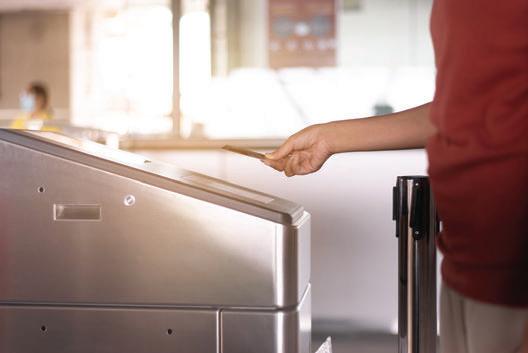



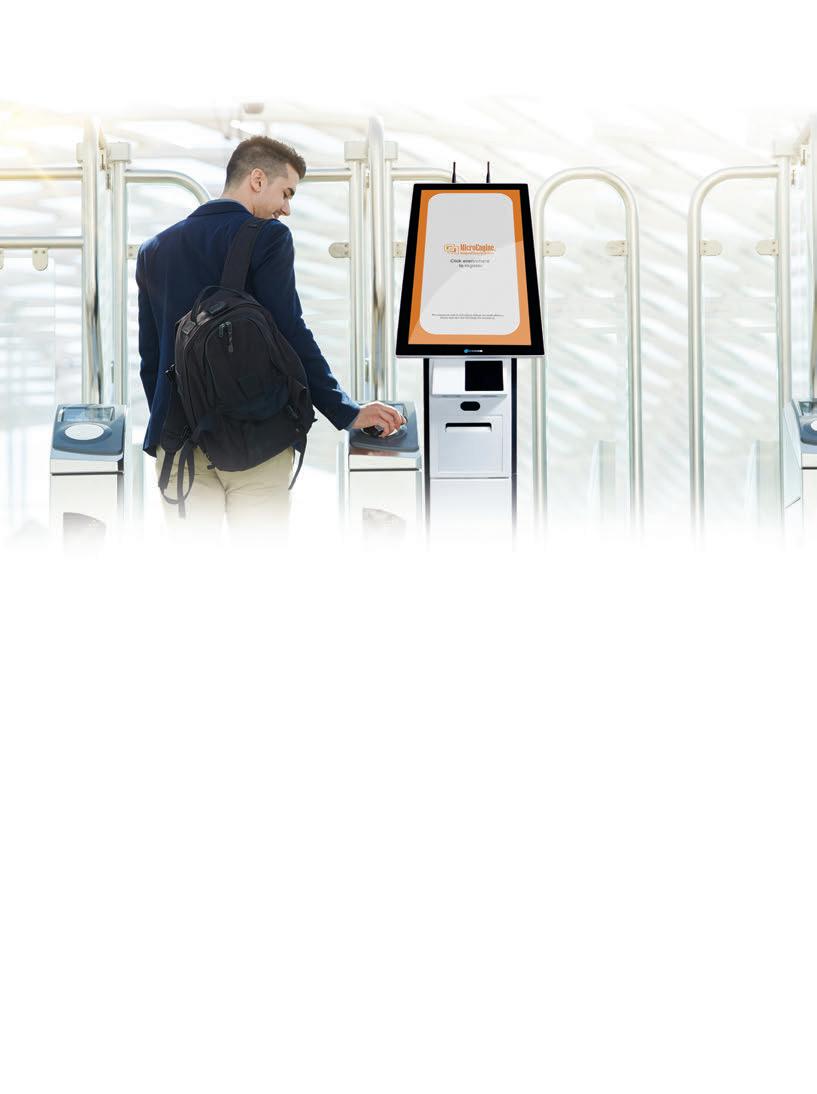


Written and Prepared by:


Datuk Ir. Ahmad Fauzi bin Hasan, an Authority Member of Sustainable Energy Development Authority (SEDA) Malaysia, was invited to speak on Updates on Energy Transition prior to the AGM at Malakoff Auditorium, Wisma IEM. The event, held on 13 May 2023, was organised by the Electrical Engineering Technical Division (EETD) of IEM.
Datuk Ir. Ahmad Fauzi, a professional engineer with 42 years of industry regulatory experience, has vast experience in performance-based regulation of the energy sector and high-risk industries based on good international practices for ensuring energy supply industry performance in aspects of security, reliability, safety, sustainability, economy and service quality.
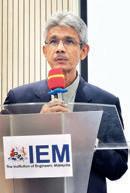
He started the talk with recent developments in global carbon emissions, showing the global carbon emissions by sector, followed by the definition to net zero, its importance, its achievability and the global efforts towards this. He said that, according to the report from United Nations Framework Convention on Climate Change (UNFCCC) titled Nationally Determined Contribution (NDC) Synthesis Report (Oct 2022), there will still be an increase in global greenhouse gas emissions projected by 2030 compared to 2010. He then shared with the audience the global carbon emissions from 1970 to 2022. The Global Renewables Outlook by IRENA (2020) illustrated the need by each sector to reduce the gigatonnes of carbon per year.
Energy production has always been a transition from coal to oil to nuclear, etc. The strategy to do so throughout the years is to reduce demand for energy-intensive goods and services, to improve efficiency in energy supply and use (at all stages in the supply chain), to expand use of low- and
zero-carbon energy sources and to capture carbon dioxide from large emission sources and to utilise/store it as well as from the atmosphere and to utilise/store it. According to Our World in Data, based on BP Statistical Review of World Energy (2020), 84.3% of global energy comes from fossil fuels, 11.4% from renewables and 15.7% from low-carbon sources. After reviewing the global energy consumption from 2000 to 2021 and the share of renewables in global power generation which continued to increase from BP Statistical Review of World Energy 2022, the renewable energy (RE) share in new generation capacity was assessed through IRENA’s renewable energy statistics.
Challenges for increased deployment of renewables were deliberated, supported with statistics on the RE intermittency challenge. It was also made known that one of the ways to address the challenge would be to use RE intermittency with energy storage technologies. Selected energy storage technology performance characteristics were compared with the grid storage needs along the value chain. The utility scale energy storage in operation in the United States and the use of green hydrogen in future energy storage systems were shown. Key drivers of energy transition included enabling policies, availability of appropriate technologies, adequate finance, availability of right skill sets and enabling legal and institutional environments.
Datuk Ir. Ahmad Fauzi then discussed the current state of energy transition in Malaysia and globally as well as the challenges and opportunities that lie ahead. He highlighted that Malaysia’s transition to reduce its reliance on fossil fuels and the transition to cleaner and more sustainable energy sources are in progress. He stressed on the importance of enabling policies in driving energy transition and concluded by highlighting a few key takeaways in accelerating Malaysia’s energy transition, as listed below:
• Future-proof support policies and strategic action plans.
• Adoption and adaptation of enabling smart technologies.
• Innovative financing framework.
• Evolution of new energy business models.

• Right skill sets and mindsets.
• Enabling legal and institutional environment.
• Government incentives for businesses to adopt renewable energy. The talk was well-received by the 50-strong audience, who appreciated Datuk Ir. Ahmad Fauzi’s insights into the future of energy in Malaysia and globally. The talk also generated a lively discussion on the challenges and opportunities facing the country in the transition to a cleaner energy future.
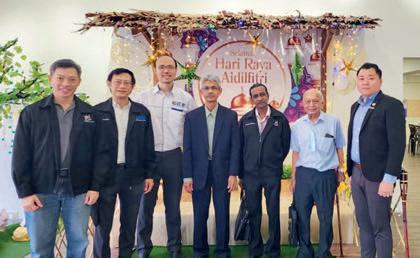
Half-Day Course on Planning Towards 100% Renewable Energy and Energy Storage Projects
Date : 18 September 2023 (Monday)
Time : 9.00 a.m. - 1.00 p.m.
Venue : Online Platform
Approved CPD : 4
Speaker : Ir. Noor Iziddin Abdullah bin Ghazali
Webinar Talk on XT Junction Design: A Malaysian Case Study Driving Towards Net Zero
Date : 19 September 2023 (Tuesday)
Time : 4.00 p.m. - 6.00 p.m.
Venue : Online Platform
Approved CPD : 2
Speakers : Mr. Steve Jones : Omar Mohsen
2-Day Course on Understanding Design and Build Projects
Date : 19 - 20 September 2023 (Tuesday - Wednesday)
Time : 9.00 a.m. - 5.30 p.m.
Venue : Online Platform
Approved CPD : 14
Speaker : Ir. Lai Sze Ching






Written and Prepared by:

As the nation’s leading network operations centre, the Telekom Malaysia Network Operation Centre (TMNOC) in Cyberjaya plays a pivotal role in delivering seamless connectivity for all Malaysians.
On 18 May 2023, 10 members of The Institution of Engineers, Malaysia (IEM) took part in a technical visit to TMNOC, the most comprehensive network operation centre of all the telcos in the country. It recently changed its name to TMNIC (Network Intelligence Centre) to reflect its evolution up the value chain rather than being just a maintenance and surveillance organisation. After the recent sale of Menara TM, Telekom Malaysia™ officially launched its new headquarters and campus in Cyberjaya. The campus houses the new TM Innovation Hub, TM Network Intelligence Centre and TM Core Data Centre.[1]
The launch is in line with the new TM brand promise, Your Next is Now, which demonstrates how technology is being harnessed to empower people to drive change and to enable them to realise their aspirations, whether it is to scale big ideas, build new businesses or take better care of the planet.[1]

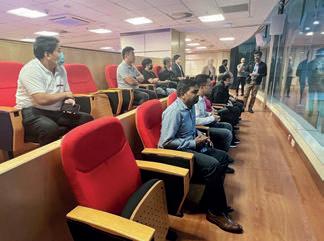
The campus has open office spaces, technology infrastructure and digital tools as well as dedicated areas for collaboration, empowering employees to deliver innovative solutions for customers.[2] This represents TM’s commitment to creating an innovative space that drives agility, flexibility and efficiency through digital collaboration and a hybrid work environment.[2] It also features a sustainable, eco-friendly design with green spaces and an abundance of natural light to create a healthy and inspiring workspace atmosphere.[2]
The Vice President of TMNOC, Ir. Jayaprakash Jayaraman, gave an interesting and comprehensive presentation of TM’s history, charter and activities from its inception in 1946 as a postal, telegraph and telephone service (PTT) entity till its corporatisation and subsequent privatisation to become one of the biggest corporations in Malaysia. PTT is the old name for a government agency responsible for postal services, telegraph and telephone services. This has since been replaced by the name telco with the postal services decoupled.
The state-of-the-art TMNOC monitors all 93,000-plus multi-domain, multi-vendor network elements nationwide and is fully staffed by TM staff in the back-office tech (L2, L3) operations. It practises a hybrid model of TM employees and subcontracting companies for field (L1) operations. Besides surveillance, the NOC is able to perform all the required configurations remotely and to record performance statistics. The network team members at NOC are the backbone of its network operations.
Since TMNOC is designated as a restricted area, visitors are not allowed to take photographs of the equipment and displays inside the NOC.
With its setup, TM has managed to effectively restore telecommunications services in recent natural disasters such as the Batang Kali landslide and Shah Alam floods, in a timely fashion, a proud achievement that has not gone unnoticed.
[1] https://technave.com/gadget/TM-HQ-and-campus-are-now-in-Cyberjaya-34364.html
[2] ht tps://www.nst.com.my/business/2023/05/907849/telekom-malaysia-launches-newcampus-hq-cyberjaya
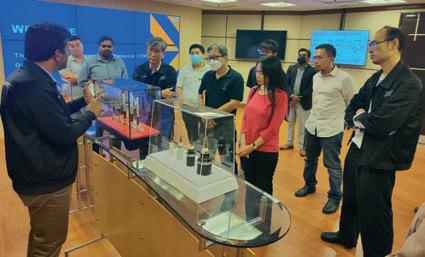

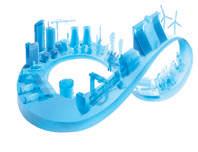









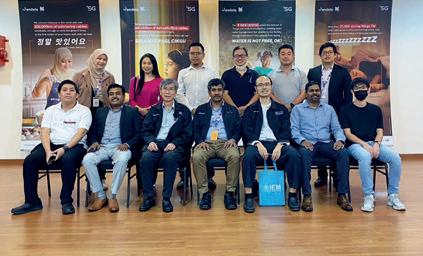









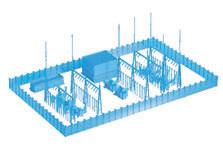
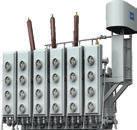










The Institution of Engineers, Malaysia (IEM) held its grand Annual Dinner 2023 on July 15 at the Imperial Ballroom in One World Hotel, Petaling Jaya. The event attracted distinguished figures from both near and far, including engineering professionals from ASEAN countries. The gathering of the engineering experts was lively and convivial as they mingled and enjoyed themselves during the pre-dinner cocktail. Many cherished moments were captured against the photo backdrop which featured the names of the generous sponsors whose support led to the success of yet another IEM anniversary dinner.
The event reached new heights of prestige when the Guest-of-Honour, YB. Dato Sri Alexander Nanta Linggi, and his entourage arrived. A hush fell over the room as attendees watched Dato Sri Alexander make his way through the crowd, pausing briefly to engage with familiar faces and those fortunate enough to have secured the Diamond and Platinum tables.

Past President IEM), Mrs. Ong, Ir.
Chau Fong (Organising Chairman, IEM Annual Dinner 2023)
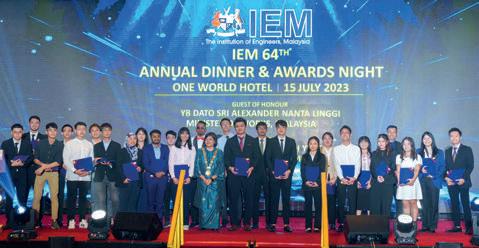
But there was a double honour for IEM that night as well, as YAB Dato’ Sri Haji Fadillah bin Yusof, the Deputy Prime Minister and Minister of Plantation Industries & Commodities, attended the event as a Distinguished Guest to be conferred the IEM Honorary Fellow.
Entertainment for the night was provided by the DBKL Band, which presented a mix of old-time classics and contemporary hits.
As was customary on such occasions, speeches were delivered and awards presented. In his speech, Dato Sri Alexander acknowledged that the engineering and
construction industries had been going through some rough patches in the last few years as they had been impacted by the Covid-19 pandemic but he believed that the country was slowly and steadily recovering. He said that as Malaysia was moving towards developed status, the role of engineers was extremely important and to no small measure, IEM had contributed much to the development of the nation.
“We just need to look at our infrastructure development and the progress achieved so far in construction to realise the enormous contributions made by the dedicated and committed pool of engineers in Malaysia,” he said.
He also acknowledged concerns over constraints faced in implementing new technology in the construction industry such as Industrialised Building System (IBS), Building Information Management (BIM) and 4IR-based technologies such as robotics, automation, big data, internet of things, etc. However, he said, the Ministry of Works will continue its effort to lead the building industry to move forward by leveraging on the aforementioned new technologies.
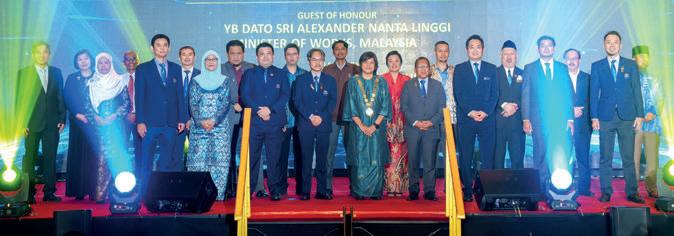
In her welcome speech, IEM President, Ir. Prof. Dr Norlida binti Buniyamin said that sustainability of IEM and the country should be the interest and responsibility of IEM members. “We must contribute to the technological advancement and development of Malaysia, using engineering knowledge sciences and our ability to help those in need. Many Malaysians need new inventions provided by the utilisation of new technology to have a better life, especially those in rural areas and those who are not well off,” she said.
Cementing their names in the annals of IEM as recipients of the IEM Honorary Fellow awards were, besides Dato’ Sri Haji Fadillah, Y.Bhg. Datuk Ir. Ahmad Redza bin Ghulam Rasool (Director General of Jabatan Kerja Raya Malaysia), Y.Bhg. Dato’ Seri Ir. Dr Zaini bin Ujang (Secretary General of the Ministry of Human Resources) and YB. Zairil bin Khir Johari (State Exco of the Penang State Government).
• Ir. Chuah Rhun Riang
• Ir. Dr Law Chung Lim
• Ir. Dr Mui Kai Yin
• Ir. Dr Mohd Rayme bin Anang Masuri
• Ir. Lau Eng Kee
Individual for Graduate Member Ir. Dr Kwong Kok Zee
Individual for Corporate Member Ir. Noreha binti Nordin
Organisation for Graduate Member Tenaga Nasional Berhad
Organisation for Corporate Member Jabatan Kerja Raya Malaysia
Schneider Electric Industries (Malaysia) Sdn. Bhd.
Champion Electrical Engineering Technical Division (EETD)
1st Runner up Geotechnical Engineering Technical Division (GETD)
2nd Runner up Civil and Structural Engineering Technical Division (CSETD)
3rd Runner up Project Management Technical Division (PMTD)
4th Runner up Chemical Engineering Technical Division (CETD)
Most Improved Public Sector Engineers Special Interest
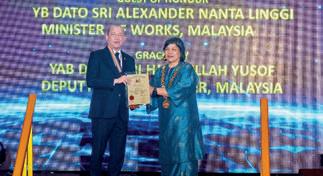
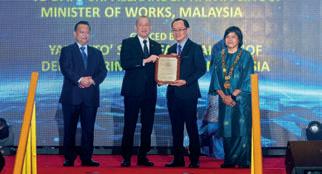
Ir. Foo Kam Fai receiving the IEM Outstanding Engineering Achievement Award from YAB Dato’ Sri Haji Fadillah bin Yusof. Looking on are YB Dato Sri Alexander Nanta Linggi (Minister of Works, Malaysia) and Ir. Prof. Dr Norlida binti Buniyamin (President, IEM)
This year, the winners of the IEM Award for Contribution to Engineering Industry received a pleasant surprise when Dato Sri Alexander Nanta Linggi consented to present the award to the winners while Dato’ Sri Haji Fadillah presented one of the highest awards of the evening, the IEM Award for Outstanding Engineering Achievement 2023, to Sepakat Setia Perunding (Sdn) Bhd for its project, the Sungai Besi, Ulu Kelang Elevated Expressway (Section A), Kuala Lumpur and Selangor, Malaysia.
Other awards presented by the IEM President included the Top Mentor Award, Top Membership Drive Award and Presidential Award of Excellence. A total of 27 students,
representing the crème de la crème in academia and would-be future leaders of the industry, received the IEM Gold Medal Award for the Best Engineering Student from local institutions of higher learning.
The dinner ended with a lucky draw. The top 10 prizes were sponsored by Camfil (M) Sdn. Bhd., Daikin Malaysia Sales & Service Sdn. Bhd., SR Aviation Sdn. Bhd. and One World Hotel. The Grand Prize winner went home with a Gintell massage chair worth approximately RM3,000.00.
The 64th Annual Dinner achieved its intended objectives, thanks to the leadership of the Annual Dinner Committee led by Ir. Yau Chau Fong (Vice President and Chair of Standing Committee on Activities). The dedicated team of volunteers worked tirelessly to ensure the success of the event. Additionally, the Secretariat, the unsung heroes behind the scenes, deserved special recognition for its invaluable contributions during the preparations, execution and post-production phases.
In conclusion, the event was a resounding success which left a lasting impression on all who attended. It served as a platform for industry professionals to connect, celebrate accomplishments and forge new partnerships. IEM can take pride in having organised the event and anticipation is already building up for the next edition. Indeed, IEM hotlines are already open to receive bookings for the 65th Annual Dinner 2024.

IEM PAoE Award Winners. (L-R) Ir. Shahidan bin Sadiman (PSESIG), Ir. A/P Dr Chong Chien Hwa (CETD), Ir. Dr Nor Azhar bin Mohd Arif (PMTD), Ir. Prof. Dr Norlida binti Buniyamin (President, IEM), Ir. Dr Siow Chun Lim (EETD), Ir. Kwong Kok Zee (CSETD), and Ir. Dr Chan Swee Huat (GETD)
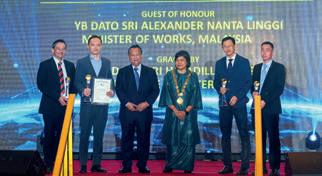
Winners of the IEM Award for Contribution to Engineering Industry 2023 (L-R) Y.Bhg. Datuk Ir. Dr Dennis Ganendra (Minconsult), Mr. Khoo Nee Kai (Veolia), YB Dato Sri Alexander Nanta Linggi (Minister of Works, Malaysia), Ir. Prof. Dr Norlida binti Buniyamin (President, IEM), Ir. Tan Ling Jin (IJM) and Mr. Lee Wai Kok (Daikin)
Award for the Highest Numbers of Virtual Activities Conducted
Champion Mechanical Engineering Technical Division (METD)
1st Runner up Project Management Technical Division (PMTD)
2nd Runner up Electrical Engineering Technical Division (EETD)
Award for the Highest Paid Numbers of Participants of Virtual Activities Conducted
Champion Mechanical Engineering Technical Division (CSETD)
1st Runner up Geotechnical Engineering Technical Division (GETD)
2nd Runner up Project Management Technical Division (PMTD)
IEM Award for Contribution to Engineering Industry in Malaysia 2023
Power Energy & Green Technology Industry Daikin Malaysia Sales & Service Sdn Bhd
Engineering Construction IJM Construction Sdn Bhd
Engineering Consultancy Practices (ECP) Minconsult Sdn Bhd
Water Industry Veolia Water Technologies
IEM Gold Medal Awards 2022
Chong Wei Lun Asia Pacific University of Technology & Innovation
Devan A/L Chadrasakaran Universiti Selangor
Liew You Hong Universiti Tunku Abdul Rahman
Tan Weng Kang INTI International Universiy
Tan Yi Qi University of Technology Sarawak
Andrew Yeow Tze Hao SEGi University & Colleges
Teh Boon Hong UCSI University
Abang Ahmad Latif bin Abang Sarbini Universiti Malaysia Sarawak
Jayson Teh Monash University Malaysia
Lim Mun Hong First City University College
Teoh Jess Yin Southern University College
Siew Jia Ning Universiti Malaysia Pahang
Tan Kai Wen MJIIT – Universiti Teknologi Malaysia
Lau Pui Ching Universiti Teknikal Malaysia Melaka
Su Yong Howe MAHSA University
Teoh Jiehan UOW Malaysia - KDU
Ravin Daaren Manyvannan Infrastructure University Kuala Lumpur
Tan Foo Wei Universiti Kebangsaan Malaysia
Nicholas Teo Yong Yeow Tunku Abdul Rahman University of Management and Technology
Lim Si Yong Curtin University Malaysia
Daniel Liew Yong Xin Universiti Malaysia Perlis
Chung Pui Leng Heriot-Watt University Malaysia Campus
Khairul Afiq bin Rohayzi Universiti Malaya
Nur Syaza Ilyana binti Mahathir Universiti Teknologi Mara
Wong Lin Yong Universiti Teknologi Petronas
Kueh Pei Gee Swinburne University of Technology Sarawak Campus
Lee Ho Yan University of Nottingham Malaysia Campus
Kepada Semua Ahli,
Tarikh: 21 Ogos 2023
SENARAI CALON-CALON YANG LAYAK MENDUDUKI
TEMUDUGA PROFESIONAL TAHUN 2023
Berikut adalah senarai calon yang layak untuk menduduki Temuduga Profesional bagi tahun 2023.
Mengikut Undang-Undang Kecil IEM, Seksyen 3.8, nama-nama seperti tersenarai berikut diterbitkan sebagai calon-calon yang layak untuk menjadi Ahli Institusi, dengan syarat bahawa mereka lulus Temuduga Profesional tahun 2023.
Sekiranya terdapat Ahli Korporat yang mempunyai bantahan terhadap mana-mana calon yang didapati tidak sesuai untuk menduduki Temuduga Profesional, surat bantahan boleh dikemukakan kepada Setiausaha Kehormat, IEM. Surat bantahan hendaklah dikemukakan sebulan dari tarikh penerbitan dikeluarkan.
Ir. Prof. Dr Zuhaina binti Zakaria Setiausaha Kehormat, IEM
PERMOHONAN BARU
Nama Kelayakan
KEJURUTERAAN AWAM
MOHD YUSMADI BIN MOHD YUSOF BE (UTM) (CIVIL, 2003)
NURUL AIN BINTI HAMBALI BE HONS (UTM) (CIVIL, 2012)
KEJURUTERAAN ELEKTRIK
AZRI BIN ABDUL RAHMAN BE HONS (UNITEN) (ELECTRICAL POWER, 2018)
LEE YIK LEONG BE HONS (MULTIMEDIA) (ELECTRICAL, 2010)
SHOLEH BIN IDRIS BE HONS (UTM) (ELECTRICAL, 2014)
KEJURUTERAAN ELEKTRONIK
ZAITON BINTI ABDUL MUTALIP BE HONS (UNIMAS) (ELECTRONIC AND TELECOMMUNICATIONS, 2000) MSc (HERTFORDSHIRE) (OPTICAL COMMUNICATION SYSTEM AND NETWORKS, 2008) PhD (WARWICK) (2016)
KEJURUTERAAN MEKANIKAL
MOHD KHAIRRUL AMRY BIN ROMLI BE (UTeM) (AUTOMOTIVE, 2013)
PERMOHONAN MENJADI AHLI KORPORAT Nama Kelayakan
KEJURUTERAAN KOMPUTER
LEE YIN SHENG BE (NUS) (COMPUTER, 2013)
KEJURUTERAAN ELEKTRIK
MEGAT ZUHAIRY BIN MEGAT
TAJUDDIN BSc (JOHNS HOPKINS) (ELECTRICAL, 1996) MSc (ULM) (COMMUNICATIONS TECHNOLOGY, 2005) PhD (UTM) (2016)
KEJURUTERAAN MEKANIKAL
MOHD NORAMIL BIN MOHD DARIL BSc (BRADLEY) (MECHANICAL, 1996) ME (UTM) (MECHANICAL, 2016)
PERPINDAHAN AHLI No. Ahli Nama Kelayakan
KEJURUTERAAN AUTOMOTIF
94644 MUHAMMAD IZAR BIN MD NOR BE HONS (UTeM) (AUTOMOTIVE, 2007)
KEJURUTERAAN KIMIA
111344 NEW WEE CHERNG ME HONS (UNIVERSITY OF BATH) (CHEMICAL, 2016)
KEJURUTERAAN AWAM
45607 PANG SZE YAN BE HONS (USM) (CIVIL, 2013)
47237 TONG SOOT MUN BE HONS (UKM) (CIVIL & STRUCTURAL, 2012)
KEJURUTERAAN ELEKTRIK
90063 AHMAD ARIFFUDDIN BIN ASHSHARI BE HONS (UniMAP) (ELECTRICAL SYSTEMS, 2015)
40211 LAI YEW CHIONG, ANDY BE (UTM) (ELECTRICAL-ELECTRONICS, 2013) MSc (NATIONAL UNIVERSITY OF SINGAPORE) (ELECTRICAL, 2019)
112701 LEVINATH A/L GANESAN BE HONS (USM) (ELECTRICAL, 2017)
100674 LIM WEE SHENG BE (UTM) (ELECTRICAL-MECHATRONICS, 2012)
109220 MOHAMAD FAIZ AZHARI BIN HUSSEIN BE HONS (UPNM) (ELECTRICAL, 2018)
100900 MOHAMAD ZULFADLI BIN ABDOL HALIM BE HONS (UniMAP) (ELECTRICAL, 2012)
108288 MOK JI YIONG, AARON BE HONS (UNIVERSITY OF MALAYA) (ELECTRICAL, 2017)
100688 MUHAMMAD ASYRAF AFIQ BIN AZMI BE HONS (UTHM) (ELECTRICAL, 2015)
64899 MUHAMMAD NUR HAZZIM BIN ABU HANIPAH BE HONS (UTeM) (ELECTRICAL, 2018)
42090 WONG THIN HAO BE (UCSI) (ELECTRICAL AND ELECTRONIC, 2013)
91022 YAP CHENG KANG BE (UM) (ELECTRICAL, 2012)
KEJURUTERAAN ELEKTRONIK
58712 NASROL FIRDAUS BIN ABDUL WAHAB BE HONS (UKM) (ELECTRICAL & ELECTRONIC, 2007)
27518 PRAKASH A/L RAJAH BE (UTM) (ELECTRICAL-TELECOMMUNICATIONS, 2005)
KEJURUTERAAN MEKANIKAL
121864 AFANDI BIN ABDUL GHANI @ HASAN BE (UTM) (MECHANICAL-MARINE TECHNOLOGY, 2001)
108461 GRACE TESSA MYRA GUNSALAM BE (SOUTHAMPTON) (MECHANICAL, 2012) MSc (IMPERIAL) (SUSTAINABLE ENERGY FUTURES, 2017)
50217 KOK TEIK SOON BE HONS (UTAR) (MECHANICAL, 2009)
61215 NOR HISHAM BIN MOHAMED MAHAYUDIN BE HONS (IIUM) (MECHANICAL-AUTOMOTIVE, 2011)
89186 YONG CHOW JWAN BE HONS (SEGI) (MECHANICAL, 2018)
PERPINDAHAN MENJADI AHLI KORPORAT No. Ahli Nama Kelayakan
KEJURUTERAAN AEROSPACE
54293 SYED IDROS BIN SYED ABDULLAH BE HONS (IIUM) (AEROSPACE, 2010) MSc (MANCHESTER) (MECHANICAL ENGINEERING DESIGN, 2013) PhD (IMPERIAL) (2019)
KEJURUTERAAN AWAM
40527 KENNETH ALBERTO BE HONS (UTM) (CIVIL, 2012)
KEJURUTERAAN ELEKTRIK
45955 ARIVINDHA RAO A/L APPANA BE HONS (TWINTECH INTERNATIONAL) (ELECTRONIC & INSTRUMENTATION SYSTEM, 2013) MSc (UMP) (ELECTRICAL POWER, 2016)
57713 JANARTHAN A/L KRISHNA MOORTHY BE (UTM) (ELECTRICAL, 2014) ME (UTM) (ELECTRICAL, 2018)
88318 MOHD FAIQ NAQUIDDIN BIN MD PAZIN BE (SYDNEY) (ELECTRICAL, 2012)
KEJURUTERAAN MEKANIKAL
41325 DEVARAJAN A/L RAMASAMY BE (UTM) (MECHANICAL-AERONAUTICS, 2002) ME (UTM) (MECHANICAL, 2006) PhD (USM) (2015)
41284 MAHENDRAN A/L SAMYKANO BE (UTHM) (MECHANICAL, 2005) ME (UPM) (MANUFACTURING, 2008) PhD (NORTH CAROLINA A&T STATE) (2015)
101985 SWEE JEE WEE, JOSHUA BE (CURTIN) (MECHANICAL, 2013)
117164 VIDYASAGAR A/L PERIYASAMY BE HONS (UNITEN) (MECHANICAL, 2015)
SENARAI PENDERMA KEPADA WISMA DANA BANGUNAN IEM
Institusi mengucapkan terima kasih kepada semua yang telah memberikan sumbangan kepada tabung Bangunan Wisma IEM. Ahli-ahli IEM dan pembaca yang ingin memberikan sumbangan boleh berbuat demikian dengan memuat turun borang di laman web IEM http://www.iem.org.my atau menghubungi secretariat di +603-7968 4001 / 5518 untuk maklumat lanjut. Senarai penyumbang untuk bulan Julai 2023 adalah seperti jadual di bawah:
The Sub-Committee of Engineering Hall of Fame under the auspices of the Standing Committee on Professional Practice is proud to invite nominations for the IEM Engineering Hall of Fame Award 2024.
It is timely and expedient to induct and to record the accomplishments of engineers in the country who have or had demonstrated particularly outstanding professional achievements and provided excellent services to the Institution, the engineering industry and the Nation.
The IEM Engineering Hall of Fame is established with the aim to confer recognition and to celebrate the accomplishments of members of the IEM:
• Who have demonstrated outstanding professional achievements.
• Who have made significant contributions to the engineering profession, the Institution of Engineers, Malaysia (IEM) and the Nation.
• Who have rendered valuable service to the Community.
The Engineering Hall of Fame will serve as the focal point or showcase of outstanding Malaysian engineers, past and present, who had or have made great contributions to the engineering profession and to the quality of life in Malaysia. Engineers honoured in the Engineering Hall of Fame
will also serve as a beacon and as role models for young engineers as well as create greater interest in engineering in general and awareness of the contributions made by outstanding engineers in the country.
Nominations for the Award are open to Malaysian citizens who are or have been Corporate Members of the IEM.
The closing date for the receipt of nominations for the IEM Engineering Hall of Fame Award is 30 September 2023
Please submit nominations to:
Honorary Secretary
The Institution of Engineers, Malaysia
Bangunan Ingenieur, Lots 60&62
Jalan 52/4, 46720 Petaling Jaya, Selangor.
The nomination form can be downloaded from the IEM website at www.myiem.org.my
For further details, kindly contact IEM Secretariat at 03-7968 4001/2
To encourage an interest in engineering and to recognise important services or contributions to engineering in Malaysia, the IEM Award for Contribution to the Engineering Profession in Malaysia is to be presented to the person(s), who has:
• Contributed to the advancement of engineering in Malaysia, and/or
• Designed and constructed an original engineering device or system of merit and applicability to industry.
This Award is open to all Malaysian citizens and permanent residents.
NOMINATIONS
• Nominations will be invited annually. The closing date for receipt of nominations for each year is 30 September.
• Nominations shall be made through a member of the Institution. Each member is restricted to one nomination per year.
• Each nomination shall be accompanied by a brief write up of the services rendered or contributions made or system designed and/or constructed together with relevant photographs and other documents.
• The Award is to be made by the Council upon recommendation by the Awards Committee.
• The Award shall comprise a metal plaque, a scroll and a sum of RM1,000.00.
The closing date for nominations is 30 September 2023
Please submit nominations to:
Honorary Secretary
The Institution of Engineers, Malaysia
Bangunan Ingenieur, Lots 60&62
Jalan 52/4, 46720 Petaling Jaya, Selangor.
The nomination form can be downloaded from the IEM website at www.myiem.org.my
For further details, kindly contact IEM Secretariat at 03-7968 4001/2
The IEM Outstanding Engineering Achievement Award is created to confer recognition to an organisation or body for outstanding engineering achievements within Malaysia. The award will be given to an organisation or body responsible for an outstanding engineering project in the country.
The basis for the award shall be an engineering achievement that demonstrates outstanding engineering skills which has made a significant contribution to the profession and to the quality of life in Malaysia. In making the selection, the following criteria will be given special consideration:
1) Contribution to the well-being of people and communities,
2) Resourcefulness in planning,
3) Creativity in the solution of design problems,
4) Pioneering use of materials and methods,
5) Innovations in planning, design and construction,
6) Unusual aspects and aesthetic values.
Engineering achievements which include, interalia, the following can be submitted for consideration:
• Bridges, Tunnels, Waterways Structures, Roads
• Telecommunications of national/international character, Power Transmission and Transportation
• Dams and Power Stations
• Ports and Harbours
• Building and Structures
• Airports
• Water Supply, Waste Disposal Projects
• Military projects such as bases, launching units, harbour facilities
• Drainage, Irrigation and Flood Control Projects
• Local design and manufacture of high technology products
• Energy, Heat, Mass Transfer
• Outstanding work in engineering research and development
• Chemical processing of indigenous raw resources such as rubber, palm oil and various other local plants
• Innovative use of local engineering materials
• Outstanding contribution in engineering education
• Original discovery of useful engineering theory
Nominations are invited from all members of the Institution. Each nomination submitted should contain a brief summary/write-up of the project in approximately 1,000 to 2,000 words together with full relevant reports on the project and three copies of supporting documentation including photographs. A project or component part thereof which has received an earlier award, from IEM does not qualify for nomination.
The closing date for nominations is 30 September 2023
Please submit nominations to:
Honorary Secretary
The Institution of Engineers, Malaysia Bangunan Ingenieur, Lots 60&62 Jalan 52/4, 46720 Petaling Jaya, Selangor.
The nomination form can be downloaded from the IEM website at www.myiem.org.my
For further details, kindly contact IEM Secretariat at 03-7968 4001/2
The objective of the Award is to encourage interest in engineering and to recognise potential among young engineers in Malaysia. The Award will be presented to the person who has shown outstanding ability and leadership qualities, either
i) in the design and/or construction of an engineering device or system of merit; or
ii) in the research and development or teaching of engineering.
In any one year, the Award may be made in either one or both of the categories mentioned above. If the Award is to be made in only one of the two category may be made in the year. The Award is open to candidate who are:
i) Registered member with the Board of Engineers, Malaysia and under 40 years of age
ii) Malaysian citizens or permanent residents of Malaysia
iii) Graduate or Corporate Members of IEM.
Photocopies are allowed. The Proposer may or may not be a member of IEM. However, each nomination shall be supported by a brief recommendation
from two Referees who are Corporate members of IEM. If the Proposer himself is a Corporate member of IEM (or higher), then he may also act as one of the two required Referees.
Future nomination will be invited bi-annually.
The Award will comprise a cash prize of RM500.00, a scroll and plaque, to be presented with due ceremony to each recipient of the Award.
The closing date for nominations is 30 September 2023
Please submit nominations to:
Honorary Secretary
The Institution of Engineers, Malaysia Bangunan Ingenieur, Lots 60&62
Jalan 52/4, 46720 Petaling Jaya, Selangor.
The nomination form can be downloaded from the IEM website at www.myiem.org.my
For further details, kindly contact IEM Secretariat at 03-7968 4001/2
The Women Engineer’s Sub-Committee under the auspices of the Welfare Committee is proud to invite nominations for the Woman Engineer Award 2024.
The primary objective of the Award is to recognise the contributions by women engineers. This Award may also incidentally encourage interest in engineering among women and encourage them to strive towards greater excellence. The Award will be presented to the woman engineer who has shown outstanding ability and leadership qualities, or has been a pioneer in any more of the following areas:
• In the design and/or construction of an engineering device or system, structural system, planned development, environmental improvements or,
• In the research and development of engineering device, systems, processes and/or materials, publication of paper or,
• In the teaching of engineering or,
• In the management of engineering projects,
• Entrepreneurship in the commercial sector.
In making the selection, the following criteria will be given special consideration:
• Contribution to the well-being of people and communities
• Resourcefulness in planning and in the solution of design problems
• Pioneering in use of materials and methods
• Innovations in planning, design and construction
• Unusual aspects and aesthetic values
The Award is opened to candidates who are:
• Registered members of the Board of Engineers, Malaysia,
• Malaysian citizens or permanent residents of Malaysia,
• Graduate or Corporate Members of The Institution of Engineers, Malaysia
The Proposer may or not be a member of IEM or BEM, or an engineer. However, each nomination shall be supported by a brief recommendation from two Referees who are Graduate or Corporate members of IEM. If the Proposer is herself either a Corporate or Graduate member of IEM (or higher), then she may also act as one of the two required Referees.
The Award shall comprise a cash prize of RM800.00, a scroll and plaque, to be presented with due ceremony to each recipient of the Award.
The closing date for nominations is 30 September 2023
Please submit nominations to:
Honorary Secretary
The Institution of Engineers, Malaysia Bangunan Ingenieur, Lots 60&62
Jalan 52/4, 46720 Petaling Jaya, Selangor.
The nomination form can be downloaded from the IEM website at www.myiem.org.my
For further details, kindly contact IEM Secretariat at 03-7968 4001/2













